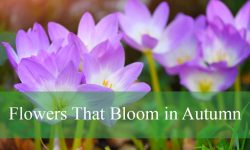When it comes to selecting the perfect cherry tree for your garden or landscape, understanding the various types of cherry trees is essential. Whether you’re looking for a tree with vibrant blossoms, sweet fruits, or ornamental beauty, the world of cherry trees offers an incredible variety. From classic sweet cherries to unique ornamental species, knowing the characteristics and growing conditions of different types of cherry trees can help you make the best choice for your space.
In this guide, we’ll explore 54 types of cherry trees, each with distinct features that make them stand out. You’ll find detailed descriptions of each variety, including their ideal growing conditions, appearance, and unique characteristics. Whether you’re a seasoned gardener or a novice, understanding the different types of cherry trees will allow you to choose the right one for your garden, adding both beauty and functionality.
Throughout this article, we’ll provide helpful pictures and identification tips for each type of cherry tree, so you can easily recognize them in person. By the end, you’ll have a comprehensive understanding of the various types of cherry trees, helping you create the garden of your dreams with the perfect cherry tree at its center.
Fruiting Cherry Varieties
Bing Cherry
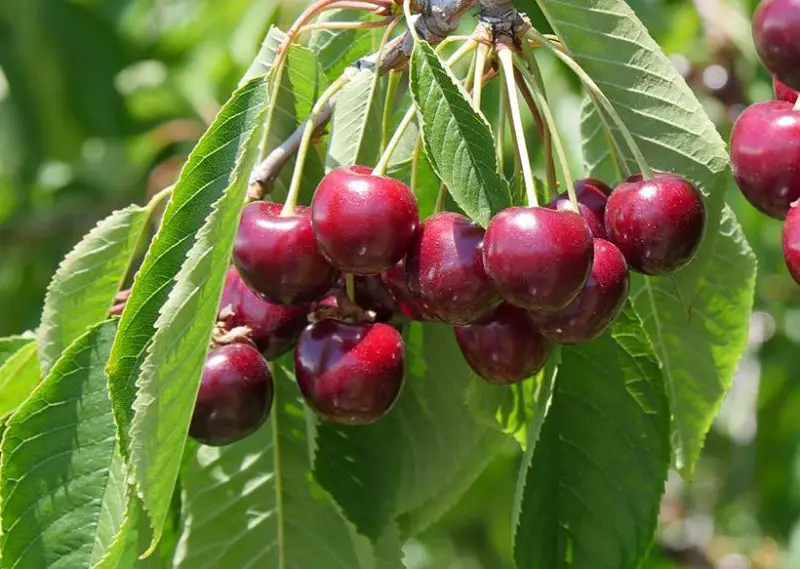
The Bing Cherry is one of the most iconic and commercially important sweet cherry varieties grown in the United States. It is renowned for its large, heart-shaped fruit with deep red to nearly black skin and firm, juicy flesh. The flavor is intensely sweet with a balanced richness, making it a favorite for fresh consumption, baking, and preserving. Its deep color and classic cherry taste have made it a staple in grocery stores and farmers markets alike.
Bing cherry trees grow best in full sun and prefer deep, well-drained loamy soil that retains some moisture but does not remain soggy. They require around 700 to 900 chilling hours during winter for proper bud formation and fruit production. These trees are not self-pollinating, so a compatible pollinator like Rainier or Black Tartarian cherry is essential for successful fruit set. Bing cherries thrive in USDA hardiness zones 5 through 8 and are moderately drought-tolerant once established.
The harvest period for Bing cherries typically falls between late May and early July, depending on the local climate. To promote healthy growth and increase yields, annual pruning is necessary to improve air circulation and reduce disease risk. Deep watering during dry spells and mulching around the base of the tree help maintain consistent soil moisture. Netting may be required to protect the ripe fruit from birds, which are particularly attracted to Bing’s sweet flesh.
Rainier Cherry
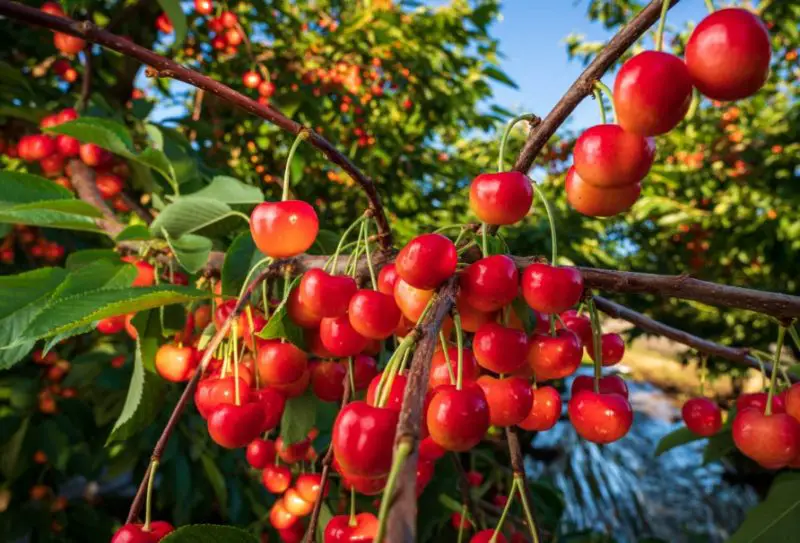
Rainier cherries are a premium sweet cherry variety distinguished by their yellow skin blushed with pink and their creamy, pale flesh. Developed in the 1950s by Washington State University, Rainier is a cross between Bing and Van cherries. Its fruit is highly prized for its superior sweetness, delicate flavor, and low acidity. Because of its attractive appearance and taste, Rainier cherries often fetch higher prices in the market and are considered a luxury fruit.
This variety prefers full sunlight and well-drained, fertile soil with moderate moisture. Rainier cherry trees are not self-pollinating and require another variety such as Bing or Black Tartarian to ensure proper fruit production. They need around 700 chilling hours during the winter and perform best in USDA zones 5 through 8. Although fairly hardy, they are sensitive to excessive heat and rain, which can cause cracking in the fruit.
Rainier cherries ripen in mid-to-late June and must be harvested carefully, as the fruit is more delicate than darker varieties and prone to bruising. To maintain tree health, prune annually to remove dead wood and open up the canopy. Consistent irrigation is critical, especially during the fruit development stage, and fruit protection measures like netting may be needed to deter birds, which are especially attracted to Rainier’s vibrant color and sweet flavor.
Black Tartarian Cherry
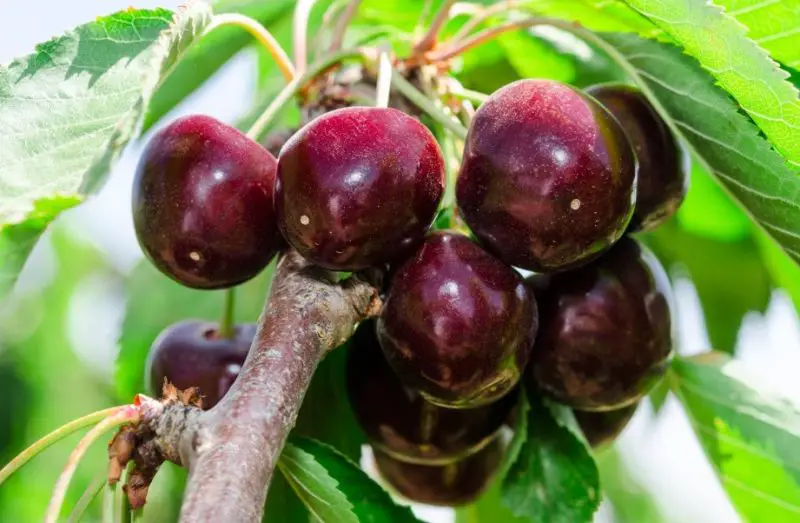
The Black Tartarian cherry is an early-ripening, sweet cherry variety celebrated for its attractive, dark purple to nearly black fruit and rich, juicy flesh. The cherries are medium to large in size and have a mild, sweet taste with subtle tartness. This variety is often enjoyed fresh, though it also performs well in jams and jellies due to its bold color and flavor.
Black Tartarian cherry trees are vigorous growers and adapt well to a variety of soils, though they prefer deep, well-drained loam and full sun exposure. These trees are not self-fertile and require a compatible pollinator such as Bing, Rainier, or Stella for effective fruiting. They thrive in USDA zones 5 through 8 and need approximately 700 to 800 chilling hours in winter to produce a healthy crop.
The cherries typically ripen in late May to early June, making Black Tartarian one of the earliest sweet cherries available in the season. The tree benefits from annual pruning to enhance airflow and light penetration, which reduces the risk of fungal infections. Consistent watering, especially during flowering and fruit development, is key to preventing fruit drop. The fruit is highly attractive to birds, so netting or scare tactics may be necessary during the ripening period.
Stella Cherry
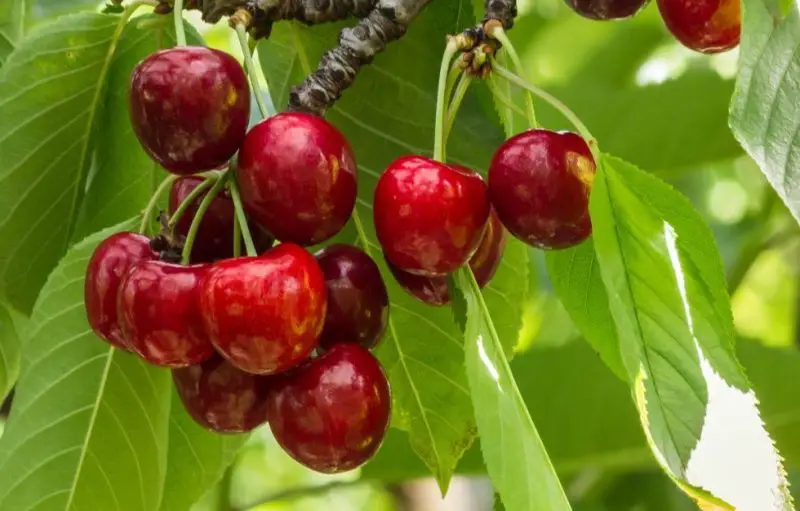
Stella cherry trees are widely appreciated for their self-pollinating nature, making them an excellent option for small orchards or home gardeners with limited space. The large, dark red fruit has a sweet, succulent flavor and firm texture, ideal for fresh eating, baking, or preserving. Stella was developed in British Columbia and became one of the first self-fertile sweet cherries available on the market.
These trees prefer full sun and grow best in well-drained, moderately fertile soils. They are adaptable to a range of soil types and are tolerant of light frost during their dormant period. Stella cherry trees thrive in USDA hardiness zones 5 through 8 and require approximately 700 chilling hours. Their self-fertility also makes them an excellent pollinator for other cherry varieties such as Bing and Rainier.
The harvest time for Stella cherries generally occurs from mid to late June. Proper care includes annual pruning to encourage strong branching and airflow within the canopy. Regular irrigation, especially during fruiting, supports healthy development, and mulching helps retain soil moisture. As with most cherry varieties, Stella cherries are vulnerable to bird damage and benefit from protective netting during the ripening season.
Montmorency Cherry
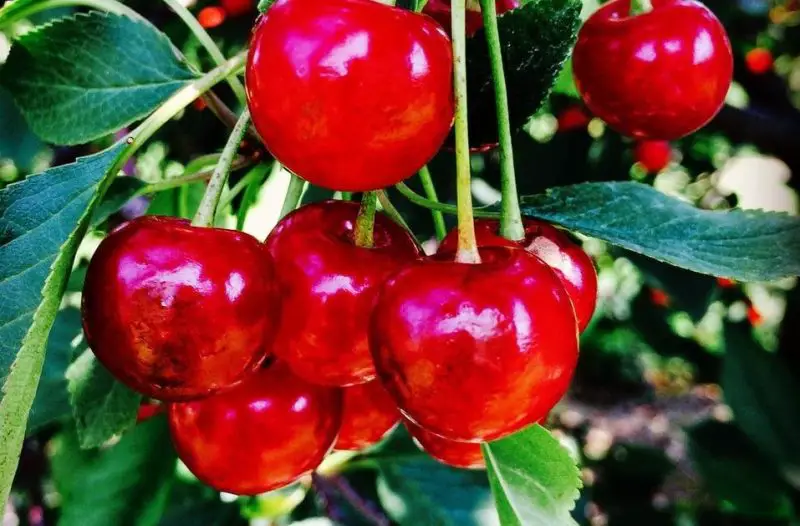
Montmorency cherries are the leading tart cherry variety in the United States and are widely used in pies, sauces, preserves, and juices. The medium-sized fruit has a vibrant red skin and pale yellow flesh, offering a bold, tangy flavor that balances well with sugar in culinary recipes. This heritage variety has been cultivated for centuries and is especially popular in the Midwest and Northeast.
Montmorency cherry trees grow best in full sunlight and in slightly acidic, well-drained soil. They are self-pollinating, making them convenient for solo planting, and are more tolerant of cold conditions than most sweet cherry types. The trees thrive in USDA hardiness zones 4 through 7 and require between 800 to 1,000 chilling hours. Their compact growth habit and productivity make them a favorite for commercial and home orchards.
The fruit is usually ready for harvest in late June through early July. Pruning should be done in late winter to early spring to promote a strong structure and remove any dead or diseased wood. Regular watering during the growing season and the use of organic mulch help maintain even soil moisture. Although Montmorency cherries are less prone to splitting, bird protection is still recommended to ensure a full, undamaged harvest.
Lapins Cherry
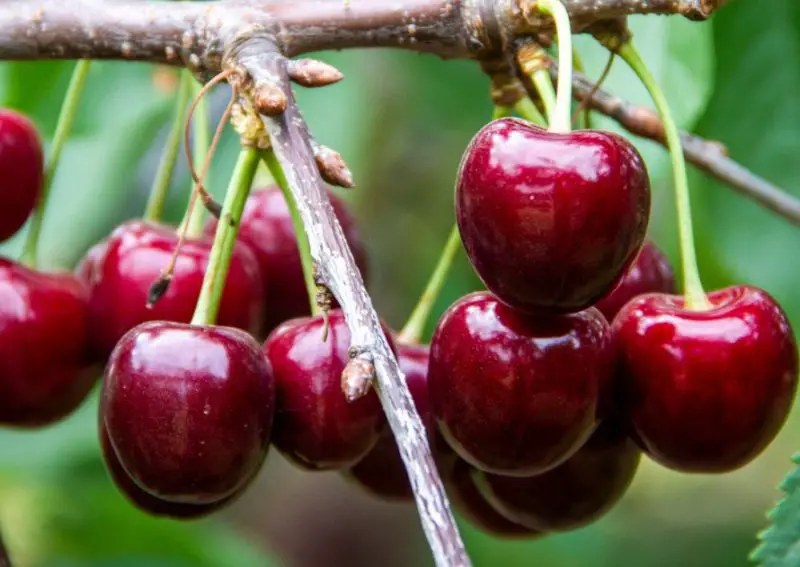
Lapins cherry is a highly regarded sweet cherry variety known for producing large, glossy, dark red fruit with excellent firmness and flavor. A self-pollinating variety derived from the Stella cherry, Lapins is valued for its consistent yields, resistance to cracking, and late harvest period. The fruit has a sweet, complex flavor that makes it ideal for eating fresh, as well as for canning and desserts.
Lapins trees are adaptable and vigorous, making them well-suited for both commercial orchards and home gardens. They prefer full sun and rich, well-drained soil, and are highly productive under optimal conditions. Lapins performs best in USDA hardiness zones 5 through 9 and typically requires 400 to 500 chilling hours, making it more versatile in regions with milder winters compared to other varieties.
Harvest usually begins in late June and can extend into early July. Pruning is essential to manage the tree’s size and shape and to improve airflow. Deep watering during dry spells supports fruit development, and a balanced fertilizer applied in early spring promotes healthy growth. Thanks to its thick skin and firmness, Lapins cherries resist splitting from summer rains, though bird netting is still advised to protect the crop.
Sweetheart Cherry

Sweetheart cherry is a late-season sweet cherry known for its glossy red skin and firm, crisp flesh with a bright, mildly tart flavor. The fruit is large and heart-shaped, offering excellent storage life and resistance to cracking. It is a favorite among growers who want a cherry that ripens after other varieties, extending the harvest season into mid to late July.
Sweetheart cherry trees are self-pollinating and highly productive, making them a great choice for home orchards and commercial growers alike. They thrive in full sun and perform best in rich, well-drained soil with moderate moisture. These trees require about 800 to 900 chilling hours and are suitable for USDA hardiness zones 5 through 8. Due to their vigor, they benefit from early training to establish a strong structure.
Harvest usually begins in mid-July and can continue into early August in cooler climates. Annual pruning is important to maintain airflow and reduce the risk of disease, especially since the trees can grow quite large. Regular watering during dry spells is key to healthy fruit development. Although the fruit is firm and crack-resistant, bird netting is still recommended, as the bright red cherries are highly attractive to wildlife.
Van Cherry
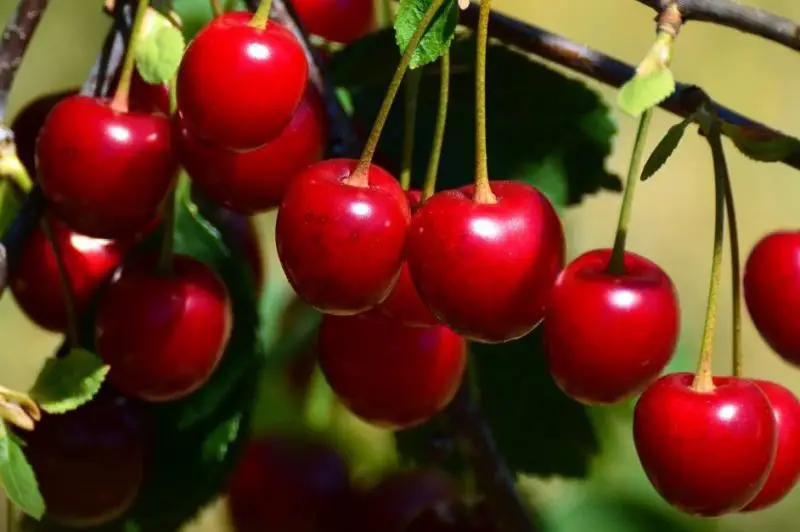
The Van cherry is a classic Canadian variety known for producing medium to large, round cherries with dark red skin and juicy, richly flavored flesh. It has a sweet taste that resembles Bing cherries, making it a reliable alternative in both fresh markets and home gardens. Van cherries are valued for their quality and consistency, especially in regions with cooler spring temperatures.
Van cherry trees are vigorous and upright in growth, and they require full sun along with well-drained, fertile soil to thrive. Unlike some other varieties, Van is not self-fertile and requires a compatible pollinator such as Bing, Stella, or Lapins for proper fruit set. It needs approximately 800 chilling hours and is best suited to USDA zones 5 through 8. The tree is known for blooming early, which can be a concern in areas with late spring frosts.
The fruit ripens in mid-to-late June, depending on the region. Pruning should be done annually to control the size of the tree and open up the canopy. Regular watering during flowering and fruiting is important, especially in dry climates. Van cherries are moderately resistant to cracking, but protective netting is often necessary to deter birds and ensure a bountiful harvest.
Lambert Cherry
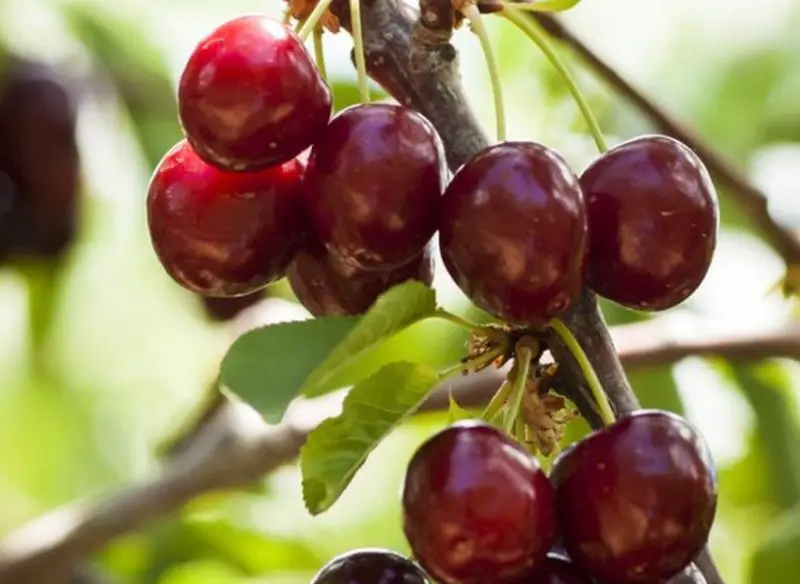
Lambert cherries are a traditional favorite among sweet cherry varieties, especially in the Pacific Northwest. The fruit is medium to large, heart-shaped, with deep red skin and a firm, richly sweet interior. It is known for its complex flavor, which has made it a favorite for both fresh eating and gourmet culinary use. Though slightly less sweet than Bing, Lambert cherries are highly prized for their texture and shelf life.
These cherry trees prefer full sun and deep, well-drained soils with good fertility. Lambert is not self-pollinating and requires another cherry tree such as Bing or Stella for cross-pollination. It needs about 700 to 800 chilling hours and thrives in USDA zones 5 through 8. The tree is moderately vigorous with an upright, spreading habit and benefits from early training to develop a strong framework.
The cherries typically ripen from mid to late June, a few days after Bing. Annual pruning is essential to promote airflow and reduce the risk of disease, especially in humid climates. During the fruiting period, deep and consistent watering is crucial to prevent premature fruit drop. Birds are particularly fond of Lambert cherries, so timely netting and bird deterrents are highly recommended.
Royal Ann Cherry
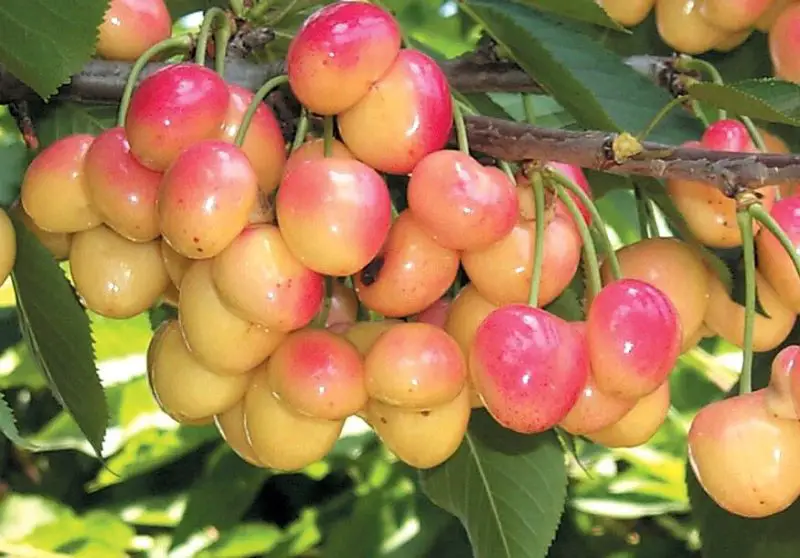
Royal Ann cherry is a light-skinned, sweet cherry variety famous for its attractive golden-yellow color with a soft red blush. It has firm, tender flesh and a sweet, mild flavor that is particularly well-suited for canning, preserving, and making maraschino cherries. Royal Ann is often compared to Rainier, although it tends to have a slightly softer texture and less complex flavor.
Royal Ann cherry trees grow best in full sun and rich, well-drained soils with moderate moisture retention. They are not self-fertile and require a compatible pollinator such as Bing, Black Tartarian, or Van for successful fruiting. These trees perform well in USDA zones 5 through 8 and need approximately 700 to 800 chilling hours each winter. Royal Ann is sensitive to excess rainfall during fruit ripening, which can cause splitting.
Harvest typically occurs in late June to early July, depending on climate conditions. Pruning each year helps manage the tree’s shape and improves airflow, reducing the likelihood of disease. Watering should be consistent throughout the growing season, especially as fruit begins to ripen. Because the fruit is light in color, birds can be particularly drawn to it, so netting is often needed to protect the crop.
Chelan Cherry
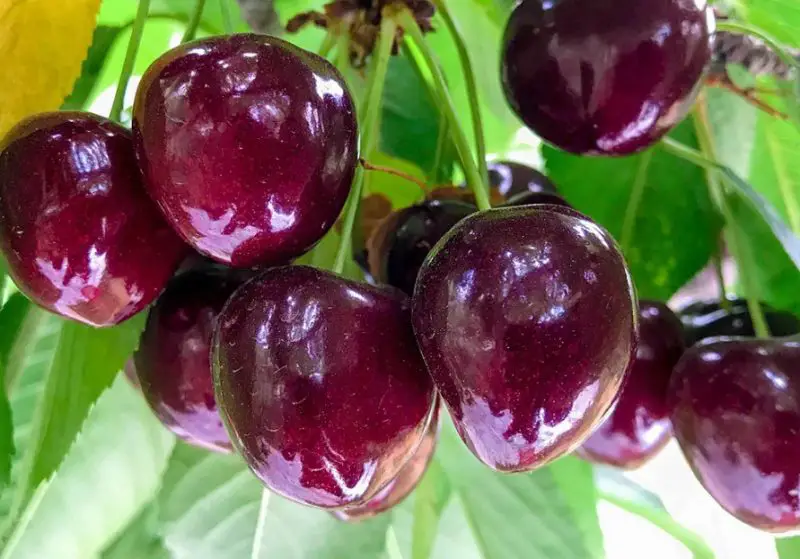
Chelan cherries are early-ripening, sweet cherries that are known for their uniform deep red color, firm flesh, and good resistance to cracking. They offer a rich, mildly sweet flavor and are often harvested up to two weeks before Bing, making them one of the first sweet cherries available in the market each season. Chelan’s early ripening and excellent shelf life have made it a commercial success.
The Chelan cherry tree grows vigorously and thrives in full sun with well-drained, loamy soil. It is not self-pollinating and requires another sweet cherry tree like Bing or Van for cross-pollination. These trees need about 800 chilling hours to fruit properly and perform best in USDA zones 5 through 8. They are less susceptible to spring frost damage due to their early blooming cycle but may need frost protection in colder regions.
Harvest begins in late May to early June, depending on the location. Annual pruning is needed to manage the tree’s size and encourage fruiting wood. Regular irrigation, especially during bloom and fruit development, supports healthy yields. Chelan cherries are relatively resistant to splitting but, like most cherries, still require bird protection to prevent crop losses.
Skeena Cherry
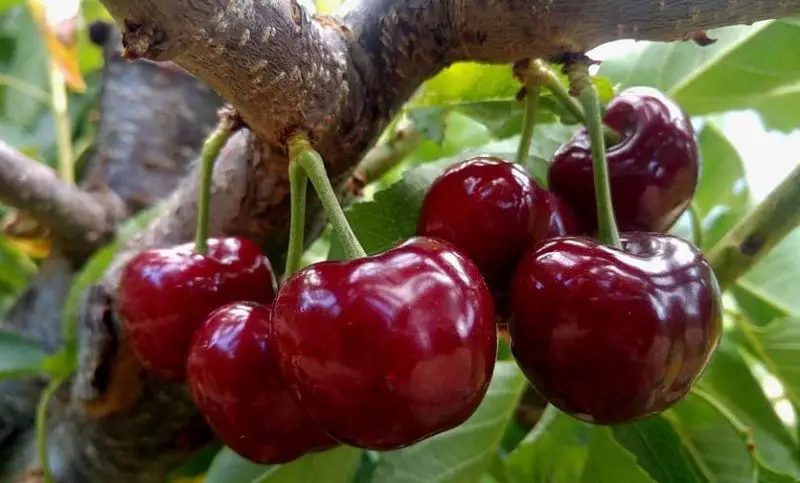
Skeena cherry is a late-season, dark red sweet cherry developed in Canada for improved flavor and resistance to splitting. The fruit is large, round, and firm with a deep burgundy color and a rich, sweet taste. Skeena is often praised for its ability to remain crack-free even during rainy conditions, making it a great choice for regions with unpredictable summer weather.
This variety performs best in full sun with deep, well-drained soil and adequate moisture. Skeena cherry trees are self-pollinating, which makes them convenient for home growers and small orchards. They require approximately 800 to 900 chilling hours during the dormant season and grow well in USDA zones 5 through 8. The trees are moderately vigorous and benefit from shaping during the early years.
Harvest generally occurs from mid to late July, extending the cherry season beyond most early varieties. Annual pruning is recommended to improve sunlight penetration and air circulation, reducing disease pressure. Regular watering, especially as the fruit begins to mature, helps maintain fruit size and quality. Because of their sweet flavor and late ripening, Skeena cherries are highly attractive to birds, so protective measures should be put in place as harvest approaches.
Tulare Cherry
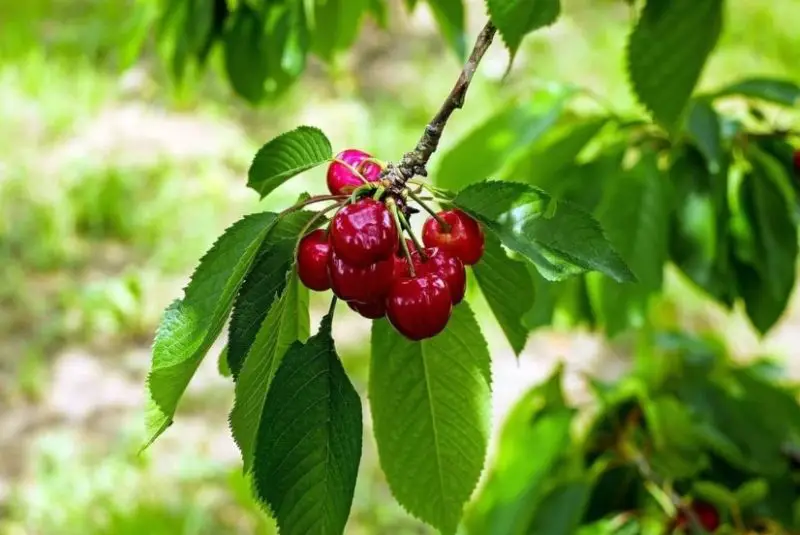
Tulare cherry is a mid-season sweet cherry known for its glossy deep red skin and firm, juicy flesh. It has a rich, sweet flavor that is slightly tangier than Bing, making it a popular choice for fresh consumption. Tulare cherries are medium to large in size and are often harvested just before Bing, allowing growers to enter the market early with high-quality fruit.
The Tulare cherry tree is moderately vigorous and grows well in full sun and well-drained, loamy soil. It is not self-pollinating and will require a compatible pollinator such as Bing or Coral Champagne to ensure proper fruit development. Tulare performs well in USDA hardiness zones 5 through 8 and requires around 800 chilling hours during dormancy. The tree has a somewhat upright growth habit and benefits from structural training in its early years.
Tulare cherries are typically harvested in early to mid-June. Regular watering during fruit development helps maintain fruit size and quality, while pruning encourages airflow and reduces disease risk. Because Tulare cherries are early ripening and brightly colored, birds may be a challenge, so using netting is often recommended to protect the crop close to harvest time.
Coral Champagne Cherry

Coral Champagne cherry is a large, firm, and sweet cherry variety that is highly valued in commercial orchards for its early ripening and appealing taste. The fruit has a light red to pinkish-red skin and crisp yellowish flesh with a mild, sweet flavor. Coral Champagne cherries are known for their excellent shipping qualities, making them a top pick for fresh markets.
The trees are vigorous growers with an upright, spreading habit, and they thrive in full sun with fertile, well-drained soil. This variety is not self-fertile and needs a pollinator such as Tulare, Bing, or Brooks. Coral Champagne is best grown in USDA hardiness zones 5 through 8 and requires about 700 to 800 chilling hours. It flowers early in the season, so spring frost protection may be needed in cooler regions.
Harvest generally begins in late May to early June. These trees require consistent irrigation, especially during the bloom and fruiting stages, to prevent splitting and ensure uniform fruit size. Pruning in late winter or early spring helps shape the tree and increase fruit exposure to sunlight. Due to its attractive fruit and early ripening, bird protection is often necessary for a successful harvest.
Brooks Cherry
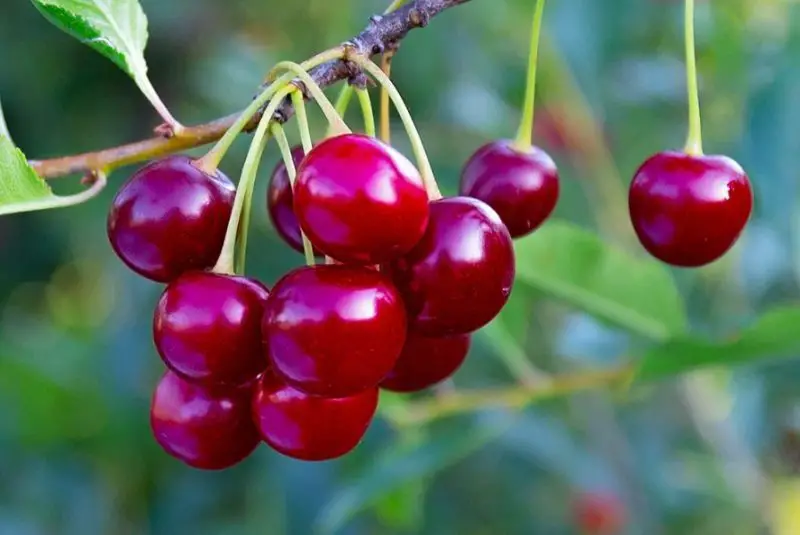
Brooks cherry is a popular early-season variety that produces medium to large, heart-shaped fruit with deep red skin and firm, sweet flesh. It has a high sugar content and a pleasantly mild flavor, making it ideal for fresh eating. Brooks is often grown in California and other warm regions due to its lower chilling requirement compared to other sweet cherries.
The Brooks cherry tree has a vigorous growth habit and performs best in full sun with well-drained, sandy or loamy soil. This variety is not self-fertile and will require a pollinator such as Tulare or Coral Champagne. Brooks thrives in USDA zones 6 through 9 and needs only around 400 to 500 chilling hours, making it suitable for growers in milder winter climates.
Harvest usually occurs in late May, ahead of most traditional cherry varieties. To maintain healthy trees and high yields, regular pruning and watering are essential, especially during hot, dry spells. Brooks cherries are somewhat sensitive to cracking, so moisture levels should be kept consistent, especially close to harvest. Bird control measures are also highly recommended due to the early, attractive fruit.
Early Richmond Cherry

Early Richmond cherry is a classic sour cherry variety prized for its tangy flavor and culinary uses. The fruit is small to medium-sized with bright red skin and pale yellow flesh. It’s too tart for most people to enjoy raw but is ideal for pies, preserves, and juices. Early Richmond is one of the earliest sour cherries to ripen, making it a popular choice for baking enthusiasts and home gardeners.
This tree has a rounded growth habit and is well-suited for smaller landscapes. It is self-pollinating and doesn’t require a companion tree to produce fruit. Early Richmond cherries grow well in USDA hardiness zones 4 through 8 and need about 800 to 900 chilling hours during winter. They prefer full sun and moderately rich, well-drained soil, and they can tolerate slightly heavier soils than sweet cherry varieties.
Harvest typically begins in late May to early June. These trees are relatively easy to care for, with annual pruning to maintain shape and promote healthy fruiting wood. Consistent watering throughout the growing season helps to prevent fruit drop and improve yield. Because of their tart flavor, Early Richmond cherries are less attractive to birds than sweet varieties, but light netting can still be beneficial.
Danube Cherry

Danube cherry, also known as Erdi Bötermö, is a flavorful sour cherry variety developed in Hungary. It’s appreciated for its larger fruit size and higher sugar content compared to traditional tart cherries, giving it a more balanced, sweet-tart flavor. The cherries are deep red with firm, juicy flesh, and they’re suitable for fresh eating, preserves, and desserts.
Danube cherry trees have a moderate growth rate and a rounded form, thriving in full sun with well-drained, fertile soil. They are partially self-fertile but benefit from having a pollinator nearby for better yields. Danube is well-suited for USDA zones 5 through 8 and requires around 700 to 900 chilling hours. The trees bloom in mid-spring and are moderately resistant to disease, especially common cherry leaf spot.
Harvest usually begins in late June to early July. Danube cherries need consistent watering, especially during flowering and fruit development, to produce juicy, well-formed fruit. Annual pruning helps shape the tree and allows better light penetration to the interior. This variety tends to attract birds due to its sweeter flavor, so protective netting is advisable as the fruit begins to ripen.
North Star Cherry
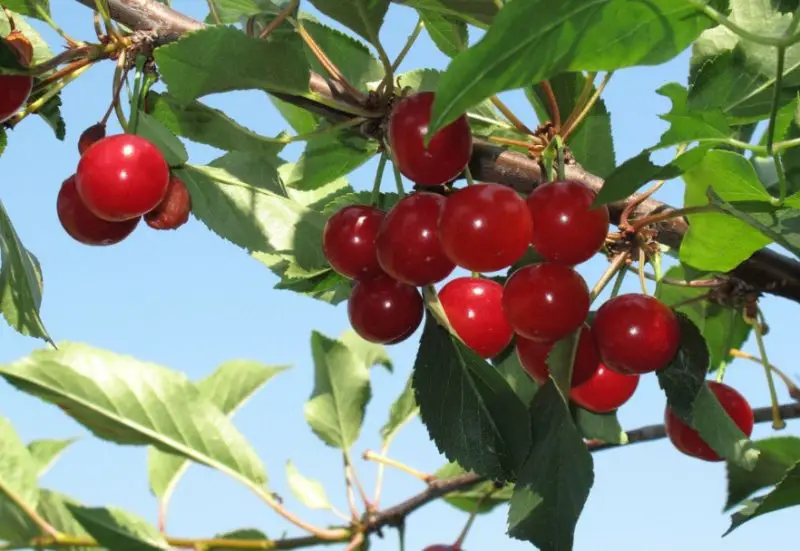
North Star cherry is a dwarf, self-pollinating sour cherry variety developed by the University of Minnesota. It produces abundant crops of small to medium-sized fruit with deep red skin and flesh, known for their tart, robust flavor. This cherry is ideal for baking, juicing, and canning, and is a favorite for those living in colder climates due to its excellent winter hardiness.
The North Star cherry tree reaches a mature height of about 8 to 10 feet, making it easy to maintain and harvest. It thrives in full sun and well-drained soil, tolerating a wide range of soil types. North Star is extremely cold-hardy and grows well in USDA hardiness zones 4 through 8. The tree blooms in mid-spring and has good resistance to common cherry diseases.
Fruit is typically ready for harvest in mid to late June. Regular watering, especially during dry spells, ensures good fruit quality, while light pruning each year keeps the tree productive and healthy. Thanks to its compact size, North Star is perfect for small gardens or container growing. Bird protection may still be needed as the bright red fruit is very appealing to wildlife.
Balaton Cherry
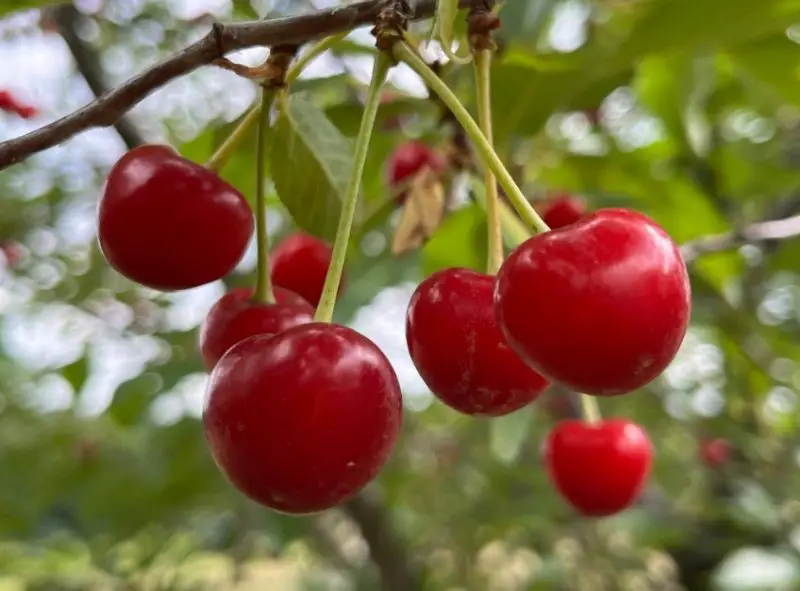
Balaton cherry is a late-ripening tart cherry known for its rich flavor, deep burgundy-red color, and excellent culinary qualities. Unlike other sour cherry types, Balaton has a sweeter taste profile, allowing it to be eaten fresh as well as used in pies, sauces, and jams. The fruit is firm and meaty, making it suitable for both home gardens and commercial orchards.
The tree has a spreading habit and grows vigorously under full sunlight in fertile, well-drained soil. It is self-pollinating, which makes it convenient for growers with limited space. Balaton cherry trees thrive in USDA hardiness zones 5 through 8 and require approximately 800 to 1,000 chilling hours during dormancy. They show good resistance to many common cherry diseases and bloom slightly later than other tart cherries, helping them avoid frost damage.
Harvest typically takes place in mid to late July, making Balaton one of the later tart cherry options. Regular watering during flowering and fruiting ensures optimal production, while annual pruning encourages airflow and healthy growth. Due to the fruit’s dark color and sweetness, bird control measures may be needed. This tree performs well in areas with cold winters and benefits from a layer of mulch to conserve soil moisture.
Meteor Cherry
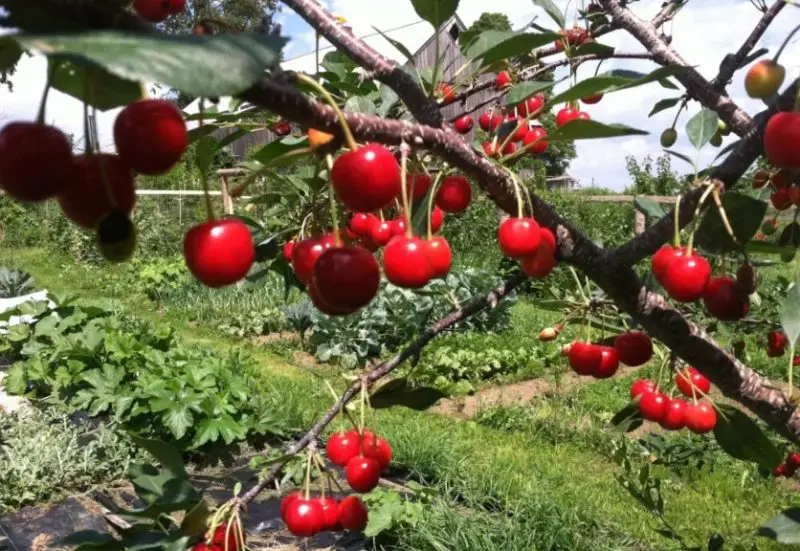
Meteor cherry is a cold-hardy, self-fertile sour cherry variety that is ideal for small spaces and backyard gardeners. It produces bright red, medium-sized fruit with a tart, juicy flavor that is perfect for pies, jellies, and preserves. The cherries have a firm texture and ripen earlier than many other sour varieties, making them a reliable early harvest option.
The Meteor cherry tree is a naturally dwarf variety, reaching a mature height of about 10 to 14 feet, which makes pruning and harvesting easy. It grows best in full sun and prefers loamy, well-drained soil. Meteor thrives in USDA zones 4 through 8 and requires around 800 to 1,000 chilling hours. It is also known for its resistance to common cherry tree diseases, such as leaf spot and canker.
Harvest begins in mid to late June, depending on local climate. Care involves deep watering during dry periods and light pruning in late winter or early spring to encourage fruiting wood and maintain shape. The bright red fruit is attractive to birds, so lightweight netting may be necessary to ensure a good yield. This cherry is an excellent option for northern climates and colder growing zones.
Craig’s Crimson Cherry
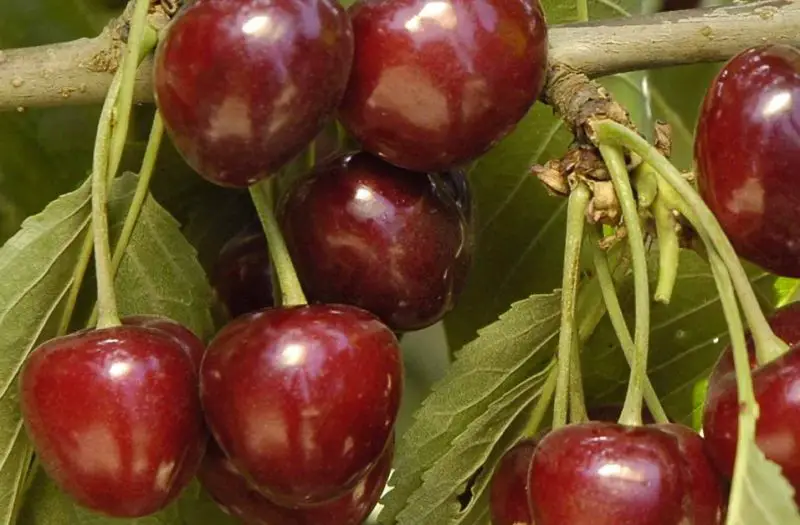
Craig’s Crimson cherry is an early-ripening sweet cherry with striking crimson-red skin and firm, juicy flesh. Its flavor is rich and well-balanced, making it suitable for fresh eating and home preserves. The cherries are slightly smaller than some commercial varieties, but their bold color and early harvest make them a favorite among home growers.
The tree grows upright and compact, reaching medium height at maturity, and thrives in full sun with well-drained, sandy or loamy soil. Craig’s Crimson is not self-pollinating and needs a suitable pollinator like Bing or Van for good fruit production. It is best grown in USDA hardiness zones 5 through 8 and needs approximately 700 chilling hours.
Harvest season begins in late May to early June. Trees benefit from consistent irrigation and mulch to retain soil moisture and suppress weeds. Annual pruning improves air circulation and encourages strong branch development. Because the fruit ripens early, it can sometimes avoid heavy bird pressure, but protection may still be required depending on your location.
Kristin Cherry
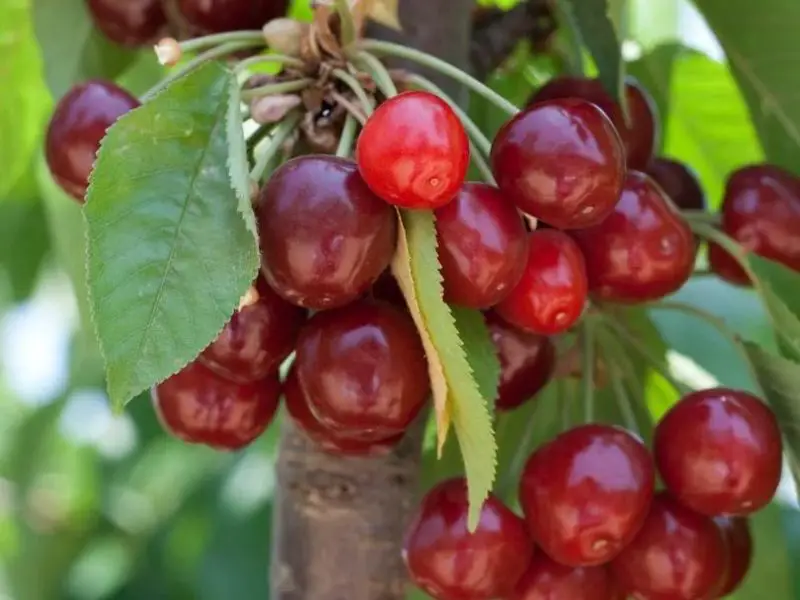
Kristin cherry is a cold-hardy sweet cherry variety that was developed in New York to withstand harsh winters. It produces dark red, heart-shaped fruit with firm flesh and a sweet, juicy flavor that is ideal for fresh eating. Kristin cherries are larger than many other cold-climate varieties and are well-liked for both backyard and small-scale commercial planting.
This tree has a strong, upright growth habit and thrives in full sun and fertile, well-drained soil. It is not self-fertile and requires a pollinator such as Lapins or Emperor Francis for optimal fruit production. Kristin grows best in USDA zones 4 through 8 and requires 800 to 1,000 chilling hours. It blooms in mid-spring, which can help it avoid late frosts.
The fruit is usually harvested in late June to early July. Regular watering during dry periods is important for fruit development, and pruning should be done annually to maintain shape and remove dead or crowded branches. Kristin’s cold tolerance makes it a great choice for northern gardens, and although it’s fairly disease-resistant, bird netting is often needed due to the appealing sweetness of the fruit.
Emperor Francis Cherry
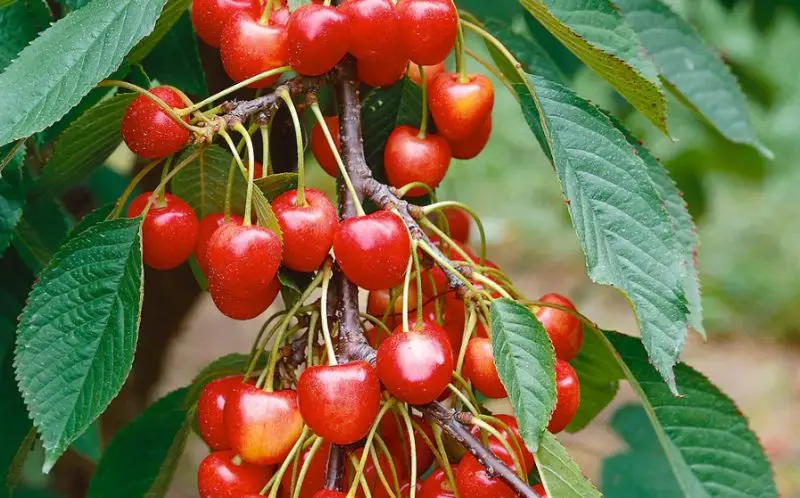
Emperor Francis cherry is a sweet cherry variety celebrated for its large, yellow fruit blushed with red. It offers a firm texture and a delicate, honey-like flavor that makes it ideal for both fresh eating and canning. It is one of the most popular yellow cherry varieties and is often compared to Royal Ann in terms of taste and appearance.
This tree grows vigorously and has a broadly rounded shape, doing best in full sun and rich, well-drained soil. Emperor Francis is not self-fertile and needs a pollinator such as Rainier or Van for best fruit set. It is suited for USDA hardiness zones 5 through 8 and typically requires around 800 chilling hours to produce abundant blooms and fruit.
Harvest occurs in late June. Because the fruit is light-colored and ripens early, it can be prone to sunburn or cracking in inconsistent moisture conditions, so it’s important to maintain even soil moisture throughout the season. Annual pruning helps maintain size and shape and improves air circulation. These cherries are particularly susceptible to bird damage, so netting is often essential for a successful harvest.
Utah Giant Cherry
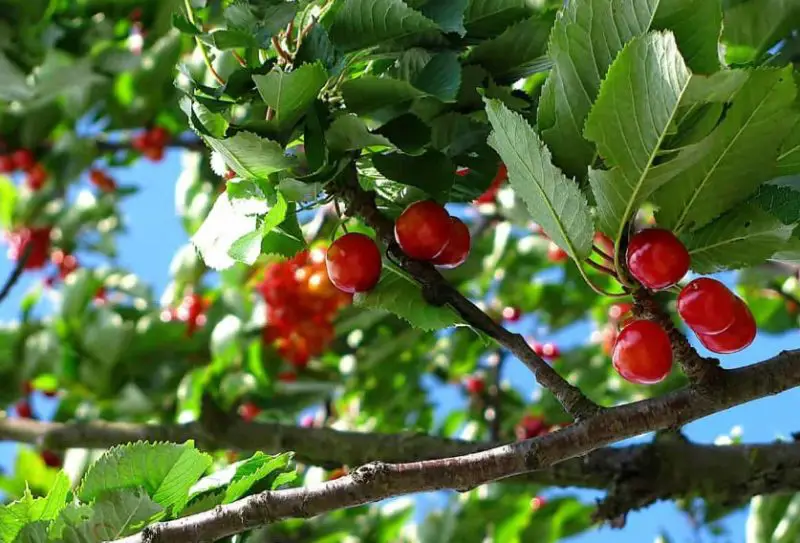
Utah Giant cherry is a prized sweet cherry variety known for producing some of the largest cherries available. The fruit is deep red, nearly black when fully ripe, and has dense, juicy flesh with a superbly sweet flavor. It is excellent for eating fresh and is a favorite in markets due to its size and shelf life.
The Utah Giant cherry tree is vigorous with a spreading growth habit and requires full sun and fertile, well-drained soil to thrive. It is not self-pollinating and will need a pollinator such as Bing or Lapins for fruit production. Utah Giant grows well in USDA hardiness zones 5 through 8 and typically needs 800 to 1,000 chilling hours. It is also noted for good disease resistance, especially to powdery mildew and bacterial canker.
Cherries are usually ready for harvest in late June to early July. The tree benefits from regular watering during the fruiting stage and from a balanced fertilizer applied in early spring. Pruning should be done annually to promote strong branches and encourage better fruit distribution. Due to the tree’s heavy yields and large fruit, bird protection is a necessity in most regions.
Ebony Pearl Cherry

Ebony Pearl cherry is a modern sweet cherry cultivar that’s known for its exceptionally large, dark-skinned fruit and rich, complex flavor. The cherries are nearly black when fully ripe, with dense, juicy flesh and a sweet, slightly tangy taste that’s excellent for fresh consumption. The fruit also holds up well in storage, making it a great option for local markets.
This tree grows vigorously with a broad, rounded canopy and does best in full sun and well-drained loamy soils. It is not self-pollinating and requires a compatible cherry tree such as Black Pearl or Stella as a pollinator. Ebony Pearl thrives in USDA hardiness zones 5 through 8 and generally requires between 800 and 1,000 chilling hours during winter dormancy.
Harvest typically begins in late June to early July. The tree benefits from regular watering during fruit development and requires annual pruning to support strong branch structure and airflow. Mulching can help conserve soil moisture and suppress weeds. Due to the high sugar content and dark color, birds are particularly attracted to the fruit, so netting is highly recommended.
White Gold Cherry
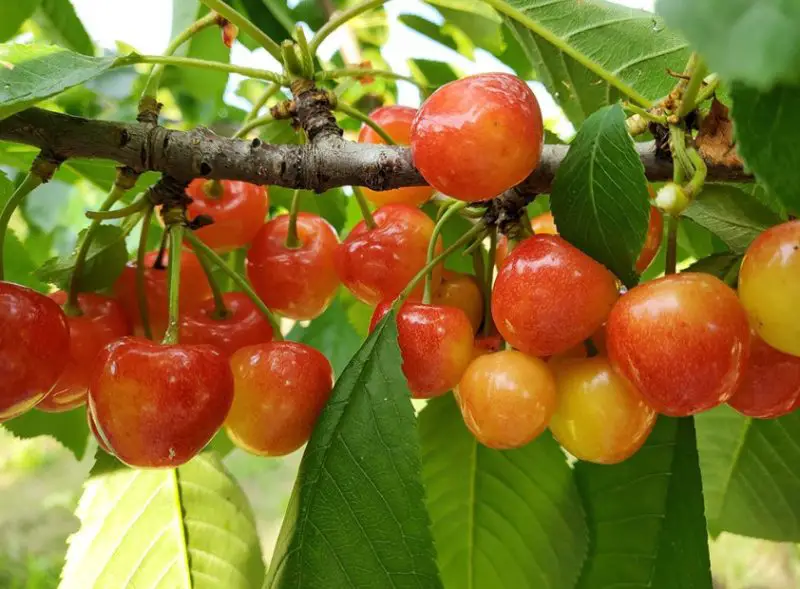
White Gold cherry is a self-pollinating sweet cherry cultivar with attractive yellow skin and a bright red blush. The fruit is medium to large in size, with a firm texture and a sweet, mild flavor. This variety is ideal for fresh eating, canning, and desserts, and is often chosen for home orchards due to its ease of care and ornamental beauty.
The tree is cold-hardy and grows in an upright, semi-dwarf form, making it ideal for smaller garden spaces. It thrives in full sun and well-drained soil and is best suited for USDA hardiness zones 5 through 7. White Gold is highly resistant to bacterial canker and other common cherry tree diseases, and it requires around 800 chilling hours.
White Gold cherries ripen in mid to late June. Since it is self-fertile, it does not require another cherry tree for pollination, although planting it near other varieties can still improve yields. The tree should be watered consistently, especially during fruit set, and pruned yearly to encourage fruiting spurs and good air movement. Its light-colored fruit is less prone to bird attacks than darker cherries, though netting may still be useful.
Black Pearl Cherry

Black Pearl cherry is a premium sweet cherry variety known for its glossy, deep purple-black fruit and intensely sweet flavor. The cherries are medium to large in size, with firm flesh and low acidity, making them perfect for fresh eating and gourmet dishes. The fruit’s beautiful appearance and long shelf life make it popular for both home growers and specialty markets.
This tree has a vigorous and upright growth habit and performs best in sunny locations with well-drained, fertile soil. It is not self-fertile and requires a compatible pollinator, such as Ebony Pearl or Bing. Black Pearl cherry trees are recommended for USDA hardiness zones 5 through 8 and need about 800 to 1,000 chilling hours during winter.
Fruit is typically ready to harvest in late June to early July. Trees need regular watering during flowering and fruiting seasons and benefit from a layer of organic mulch to retain moisture and suppress weeds. Annual pruning improves fruit production and helps maintain a manageable shape. Due to the fruit’s dark color and sweetness, bird protection is essential for a successful crop.
Royal Crimson Cherry

Royal Crimson cherry is a unique low-chill, self-fertile sweet cherry variety that produces vibrant red-skinned fruit with firm, juicy flesh and a rich, aromatic flavor. The cherries are medium-sized and excellent for fresh eating, with a taste often described as both sweet and floral. Its early bloom and harvest season make it a standout in warmer regions.
The tree is moderately vigorous with an upright growth habit and performs well in USDA zones 7 through 10. Unlike many traditional cherry trees, Royal Crimson requires only 200 to 300 chilling hours, making it ideal for southern climates with mild winters. It is self-pollinating, which means it does not require a second variety for fruit set.
Harvest typically begins in early to mid-May. Royal Crimson benefits from consistent watering and well-draining soil, and it responds well to light pruning to maintain shape and promote healthy fruiting wood. Because it flowers early, care should be taken to avoid frost damage in areas that experience unexpected late chills. The fruit’s sweetness can attract birds, so netting or other deterrents may be necessary.
Minnie Royal Cherry
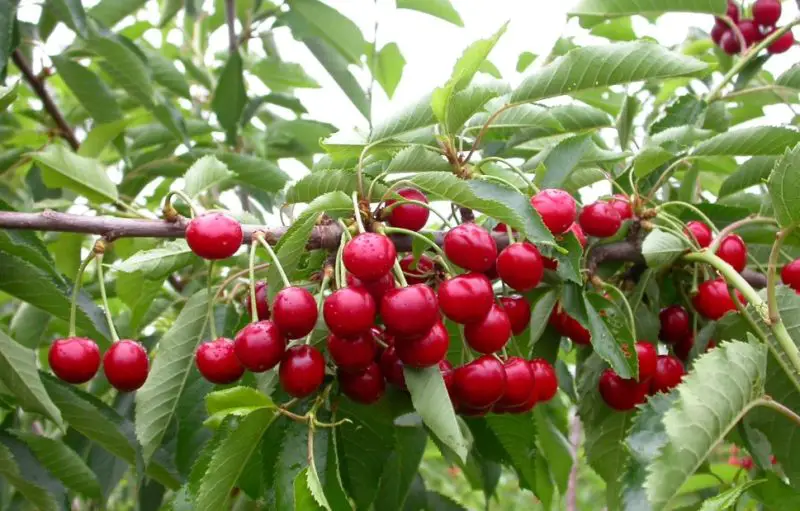
Minnie Royal cherry is one of the best early-season sweet cherry varieties, especially suited for warmer climates. The fruit is bright red with firm flesh and a pleasantly sweet flavor, ideal for fresh consumption. It is often grown alongside Royal Lee cherry as a pollination partner since the two bloom at the same time.
This tree grows with a vigorous upright habit and thrives in full sun and well-drained soil. Minnie Royal requires only 200 to 300 chilling hours and is best grown in USDA hardiness zones 7 through 10. It is not self-pollinating and must be paired with another compatible variety like Royal Lee for reliable fruit production.
The harvest begins as early as mid to late May, making it one of the first cherries of the season. Regular watering and mulching are essential, especially in warm climates, to retain soil moisture. Annual pruning improves air circulation and controls height. Early ripening means the fruit can often avoid pest pressures that peak later in the season, but bird protection may still be needed.
Royal Lee Cherry
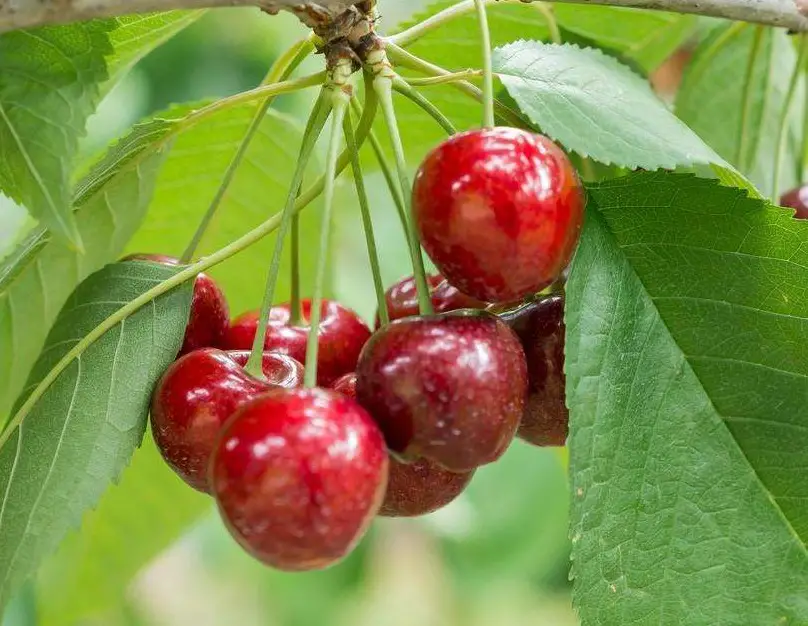
Royal Lee cherry is a low-chill, early-season sweet cherry that produces deep red, heart-shaped fruit with firm, sweet flesh. It has a complex flavor and ripens early in the season, making it popular in regions with mild winters. The cherries are suitable for fresh eating, baking, or preserving and are especially enjoyed for their intense sweetness.
The tree grows upright and compact and thrives in USDA hardiness zones 7 through 10. Royal Lee requires only 200 to 300 chilling hours and performs well in areas with short, warm winters. It is not self-fertile and requires a pollination partner, with Minnie Royal being the most effective option due to synchronized bloom times.
Fruit is ready for harvest in mid to late May. The tree benefits from full sunlight, regular watering, and light annual pruning to enhance fruit production. Because Royal Lee blooms and ripens so early, it can often avoid many pests and diseases common to cherries. However, its sweet fruit is still very appealing to birds, so netting or other protective measures are recommended.
English Morello Cherry
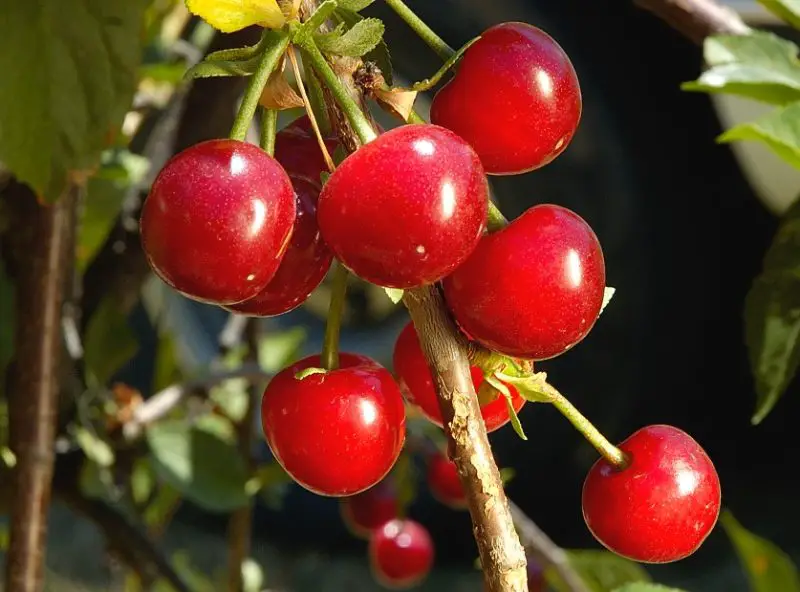
English Morello cherry is a tart cherry variety known for its dark red to almost black skin and its distinctively sour flavor. This variety is perfect for baking, preserves, jams, and sauces due to its vibrant, tangy taste that deepens when cooked. The fruit is small to medium-sized, with a rich, juicy texture that contrasts nicely with the sweetness found in many other cherry varieties.
The tree grows best in full sun and well-drained soil, thriving in USDA hardiness zones 5 through 8. It is self-pollinating, meaning it does not require another cherry tree for fruit production, although planting it near other cherry varieties can still improve yields. English Morello cherries are cold-hardy and can tolerate slightly colder temperatures than other sweet cherry types, making it suitable for cooler climates.
Harvesting usually occurs in mid to late summer, depending on the local climate. The tree requires regular watering during dry spells, particularly when fruit is developing. Pruning is important to maintain a manageable size and ensure good airflow for healthy fruit production. Due to its tartness, this variety is often shielded from birds, though netting is still helpful during the harvest period.
Vandalay Cherry

Vandalay cherry is a self-pollinating sweet cherry cultivar known for its large, deep red fruit and excellent flavor. The cherries are firm and sweet with a rich, satisfying taste that makes them perfect for fresh eating. This variety is a hybrid, developed from the Van and Stella cherry types, and combines the best traits of both parent varieties, offering a hardy and productive tree.
This tree thrives in USDA hardiness zones 5 through 8 and performs best in full sun and well-drained soil. Being self-pollinating, Vandalay does not require a second cherry tree to produce fruit, although it can benefit from cross-pollination to enhance fruit yield. It is resistant to some common cherry diseases, making it an easy variety for home gardeners to grow.
Harvest typically occurs in early to mid-summer, with fruit ripening around late June or early July. Regular watering during the growing season is essential, especially as the tree begins to produce fruit. Pruning to remove dead or crowded branches and thinning out the canopy will help improve airflow and fruit production. Birds are attracted to its sweet fruit, so netting may be necessary to protect the harvest.
Benton Cherry
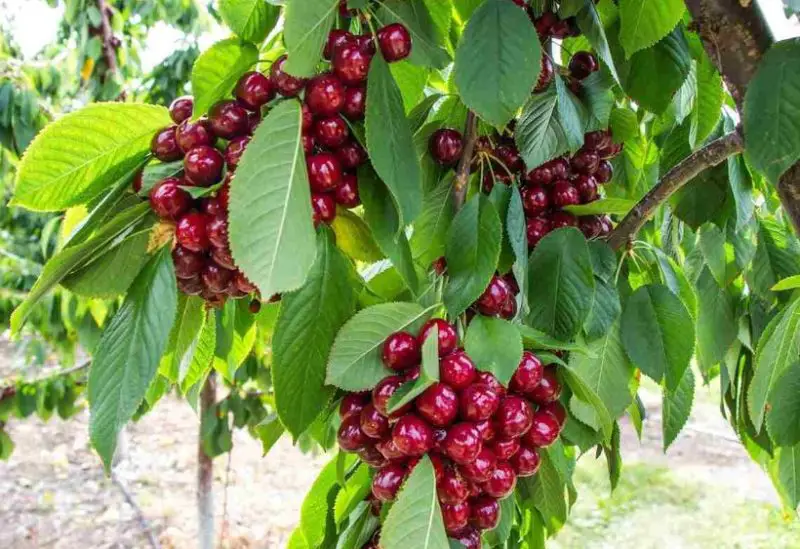
Benton cherry is an early-ripening variety that is known for its large, flavorful fruit and early fruit set. The cherries have a deep red color and a balance of sweet and tart flavors, which makes them versatile for both fresh eating and culinary uses. Benton cherries are particularly appreciated for their high-quality fruit, which is firm and holds up well when processed.
This variety thrives in full sun and well-drained soil, doing best in USDA hardiness zones 5 through 8. Benton cherry trees are self-pollinating, which means that they do not need another tree for pollination, although having a second cherry tree nearby can improve fruit production. The tree is generally hardy and resistant to common cherry tree diseases.
The harvest typically takes place in mid to late spring, about 3 to 4 weeks earlier than many other sweet cherries. Benton cherries should be watered consistently, particularly in the summer months. Annual pruning will help improve the structure of the tree and increase airflow around the branches, promoting healthier fruiting. Due to its early ripening, Benton cherries may escape some of the bird problems that can affect later-ripening varieties.
Sunburst Cherry
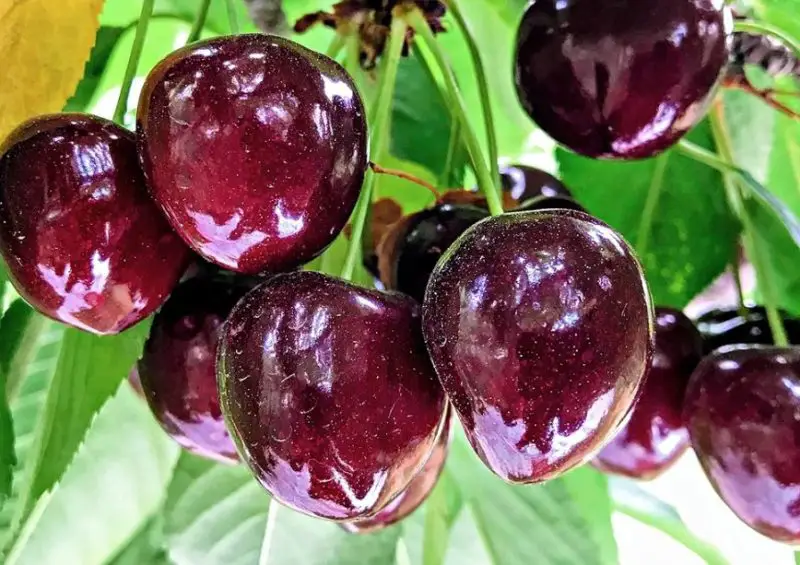
Sunburst cherry is a sweet variety known for producing large, juicy fruit with a rich, sweet flavor. The cherries are firm and bright red when fully ripe, making them excellent for fresh consumption or use in desserts. Sunburst cherries are appreciated for their high yield and robust flavor, which makes them a popular choice for both commercial and home growers in regions such as the UK and Australia.
The tree grows best in full sun and prefers well-drained, fertile soil. It is hardy in USDA zones 5 through 8 and requires at least 800 chilling hours during winter for optimal fruit production. Sunburst cherries are typically self-fertile, though planting a compatible pollinator nearby can boost fruit yield. The tree is also relatively resistant to common diseases, making it easier to manage for growers.
Harvesting occurs in mid to late summer, typically in July, depending on the local climate. The tree benefits from regular watering, especially during the fruit development stages. Pruning should be done annually to maintain the tree’s shape, improve air circulation, and promote strong fruiting wood. As with other sweet cherries, bird protection may be necessary to ensure that the fruits are not eaten before they are harvested.
Regina Cherry
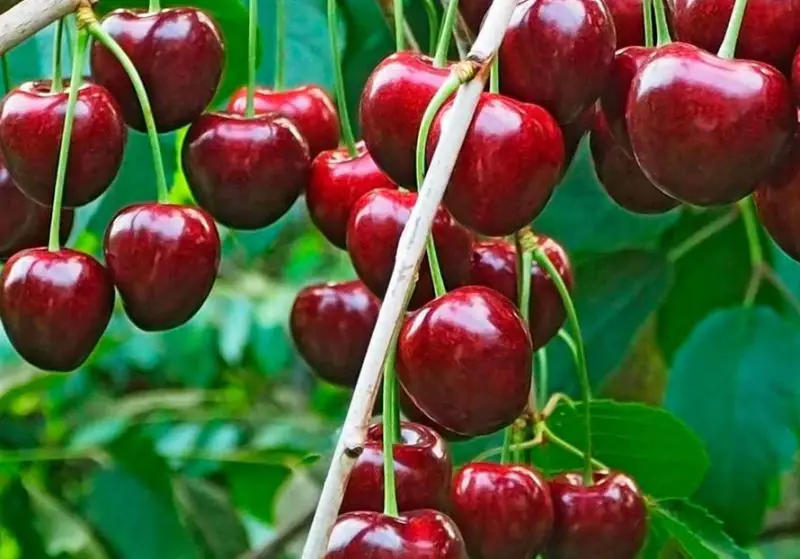
Regina cherry is a German-developed sweet cherry variety known for its deep red fruit and resistance to cracking. The cherries are large and have firm, juicy flesh, with a complex, sweet flavor. This variety is particularly favored for its ability to resist splitting, which makes it a good option for areas with fluctuating weather conditions, including heavy rain during the harvest season.
The Regina cherry tree grows best in full sun and well-drained soil. It thrives in USDA hardiness zones 5 through 8 and requires around 800 chilling hours during the winter months. This variety is not self-pollinating, so it requires a pollinator such as Bing or Van to ensure a successful harvest. The tree is resistant to common cherry tree diseases, making it an excellent choice for growers looking for a low-maintenance variety.
Harvest typically occurs in mid to late summer, around late June or early July. Regina cherries should be watered consistently during dry periods, particularly during the fruit-set stage. Regular pruning to remove dead or diseased wood and maintain a healthy canopy will help improve airflow and fruit production. While Regina cherries are generally resistant to disease, bird netting can be beneficial to protect the fruit from birds attracted to the sweet, large cherries.
Napoleon Cherry
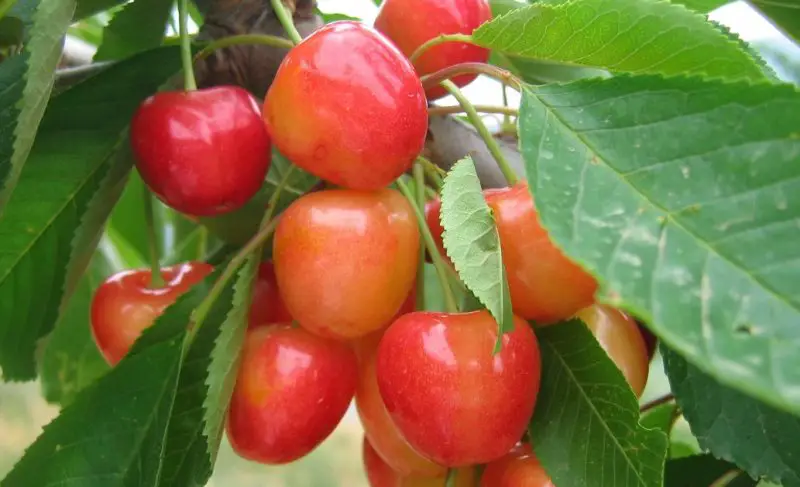
Napoleon cherry, also known as Royal Ann, is a large, golden-yellow sweet cherry variety that is celebrated for its versatility in both fresh eating and culinary applications. The cherries are firm, with a balanced flavor that is both sweet and mildly tart. Napoleon cherries are often used in desserts, fruit salads, and canning due to their beautiful color and pleasant taste.
This variety thrives in full sun and well-drained soil, performing best in USDA hardiness zones 5 through 8. Napoleon cherries are self-fertile, meaning they do not require a pollinator to produce fruit, though planting them near another cherry variety can enhance yields. They are relatively resistant to diseases, but proper care is still necessary to ensure healthy fruit production.
Harvest typically begins in early to mid-summer, usually in June. Napoleon cherries require regular watering, especially during the fruit-setting phase. Pruning is essential to maintain a manageable shape and to encourage healthy fruit production. As with most cherry varieties, bird protection is often necessary, as the bright golden fruit can attract a variety of avian pests before the cherries are fully ripe.
Early Burlat Cherry
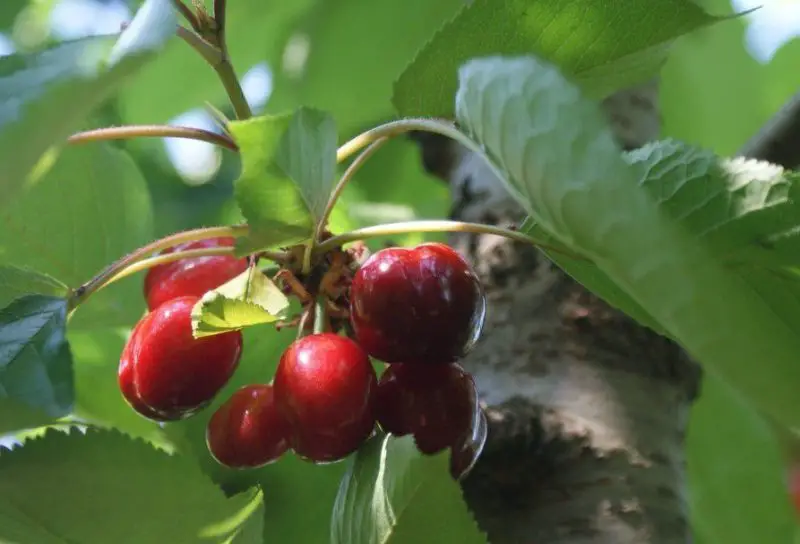
Early Burlat cherry is a prized early-ripening variety known for its soft, juicy flesh and vibrant, dark red skin. This variety is one of the first cherries to ripen in the season, making it a valuable option for early harvests. The fruit is sweet and mild, with a smooth texture that is excellent for fresh eating or using in pies and preserves. Due to its early ripening, Early Burlat cherries are highly sought after by growers looking to get a head start on the cherry season.
This variety thrives in full sun and well-drained soil, growing best in USDA hardiness zones 5 through 8. Early Burlat cherries are self-fertile but are often used as a pollinator for other varieties, such as Bing cherries, due to their earlier blooming and fruiting cycle. The tree is moderately resistant to common cherry diseases, but care should be taken to prevent fungal infections in humid climates.
Harvesting begins in early to mid-summer, typically in late May to early June, depending on the local climate. Regular watering is necessary, especially during dry periods, to ensure the fruit develops properly. Pruning should be done annually to remove any dead or diseased wood and to maintain the tree’s shape for optimal air circulation and fruit production.
Index™ Cherry

Index™ cherry is a medium-to-large variety known for its firm, dark red fruit and excellent flavor. The cherries are sweet with a rich, complex taste and a satisfying, crisp texture, making them perfect for fresh consumption, desserts, or canning. This variety is also prized for its high-quality fruit, which remains firm even after ripening, ensuring it has a long shelf life and is resistant to bruising during handling.
The tree grows best in full sun and well-drained, fertile soil, thriving in USDA hardiness zones 5 through 8. Index™ cherries are self-pollinating, which makes them convenient for home gardeners who do not have room for multiple trees. However, planting them near another compatible cherry variety can improve fruit yields. This tree is relatively resistant to common cherry diseases, although it still benefits from regular care to maintain healthy growth and fruit production.
Harvesting takes place in mid to late summer, typically in July. The tree requires consistent watering, particularly during fruit development, to ensure the cherries reach their full size and flavor potential. Pruning should be done annually to remove any dead or damaged wood and to maintain the tree’s structure. To prevent bird damage, netting is often used to protect the fruit when it is ripe.
Chinook Cherry
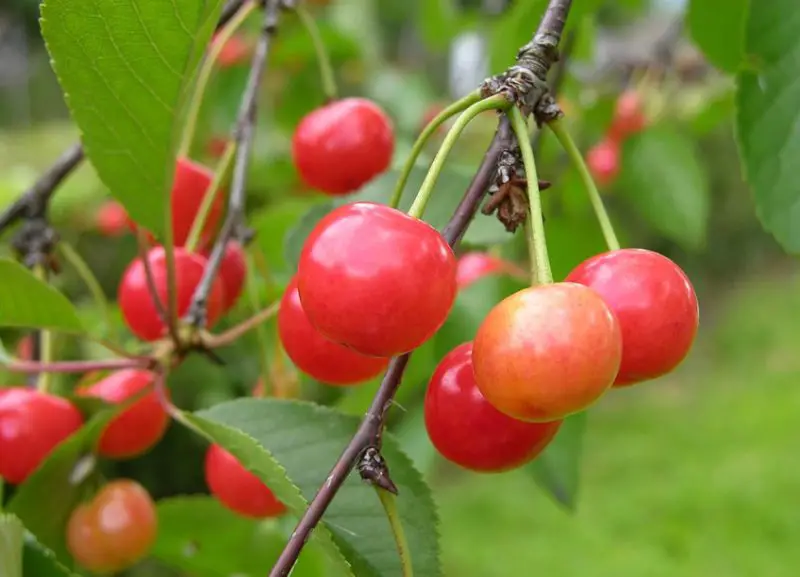
Chinook cherry is a hybrid variety resulting from the cross between the Bing and Gil Peck cherries. This variety produces large, sweet cherries with soft flesh and a balanced flavor. The cherries are dark red, often with a hint of purple, and are favored for their sweetness and juiciness. Chinook cherries are perfect for fresh eating, desserts, and canning, though they can sometimes be prone to rain cracking due to their soft flesh.
Chinook cherry trees thrive in USDA hardiness zones 5 through 8 and require full sun and well-drained, fertile soil for optimal growth. They are not self-pollinating, so they require another cherry variety for cross-pollination, with Bing cherries being a good choice. Chinook cherry trees are moderately resistant to diseases but may require extra care in humid climates to prevent fungal infections and cracking.
The fruit typically ripens in mid to late summer, around late June to early July, depending on the region. Regular watering is essential, particularly in the lead-up to the harvest, to ensure the cherries reach their full potential. Pruning is necessary to maintain healthy growth, improve airflow, and encourage strong fruiting. Bird netting is recommended to protect the cherries, especially during the vulnerable ripening period when birds may be attracted to the soft fruit.
Ornamental Cherry Varieties
Okame Cherry
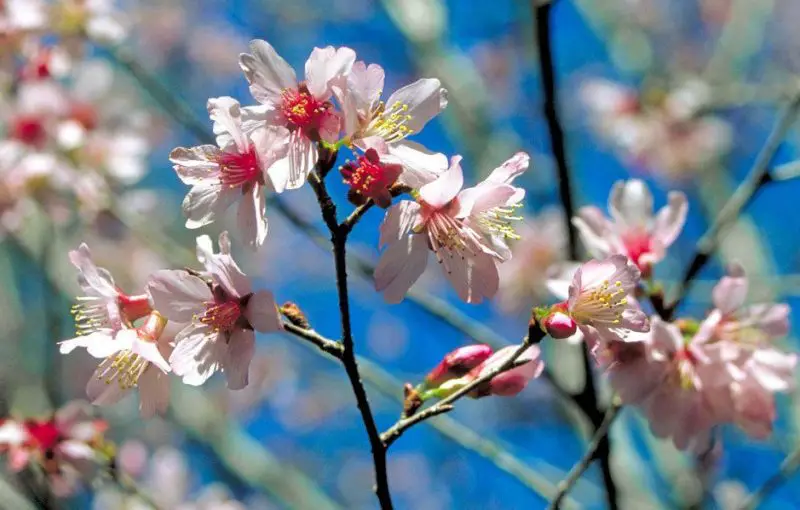
Okame cherry is a stunning ornamental cherry tree known for its vibrant pink flowers that bloom early in spring, providing a beautiful display of color. The tree has a graceful, rounded shape and a moderate growth rate, making it a perfect choice for small gardens or as a focal point in landscapes. The flowers appear before the leaves, creating a striking contrast of pink blossoms against the bare branches, which can be enjoyed for several weeks.
This cherry variety thrives in USDA hardiness zones 5 through 8, preferring full sun and well-drained soil. Okame cherry is a relatively low-maintenance tree, although it benefits from regular watering during dry spells to support its growth and flowering. It is moderately resistant to diseases, but occasional care may be needed to prevent issues like leaf spot or powdery mildew.
Okame cherry trees are generally compact, reaching a height of around 15 to 25 feet, making them ideal for residential landscapes. They bloom in early spring, typically in March to April, depending on the climate. Pruning is minimal but should be done after the blooming period to maintain the tree’s shape and remove any dead or diseased branches. This ornamental cherry attracts pollinators and provides a picturesque display, especially in gardens or along streetscapes.
Kwanzan Cherry

Kwanzan cherry is one of the most popular ornamental cherry trees, known for its double-pink flowers that appear in mid to late spring. The blossoms are large, vibrant, and create a spectacular show, with the tree often covered in masses of fluffy pink petals. The Kwanzan cherry’s dense, rounded canopy offers a bold aesthetic in landscapes, with the rich color providing an eye-catching focal point.
This ornamental variety grows best in full sun and well-drained soil, flourishing in USDA hardiness zones 5 through 9. The tree is relatively low-maintenance, though it appreciates regular watering, particularly during dry spells. Kwanzan cherry trees are hardy and resistant to many common pests and diseases but may occasionally need protection from aphids or fungal infections in humid climates.
Kwanzan cherry trees typically reach a height of 15 to 25 feet and have a similar spread, making them ideal for small to medium-sized gardens or parks. The flowers bloom in mid-spring, typically in April or May, creating a short but spectacular floral display. After flowering, the tree’s leaves turn a rich green, and in fall, the foliage turns yellow to orange, adding additional seasonal interest. Pruning should be done after the tree has bloomed to maintain its shape and remove any damaged or weak wood.
Yoshino Cherry
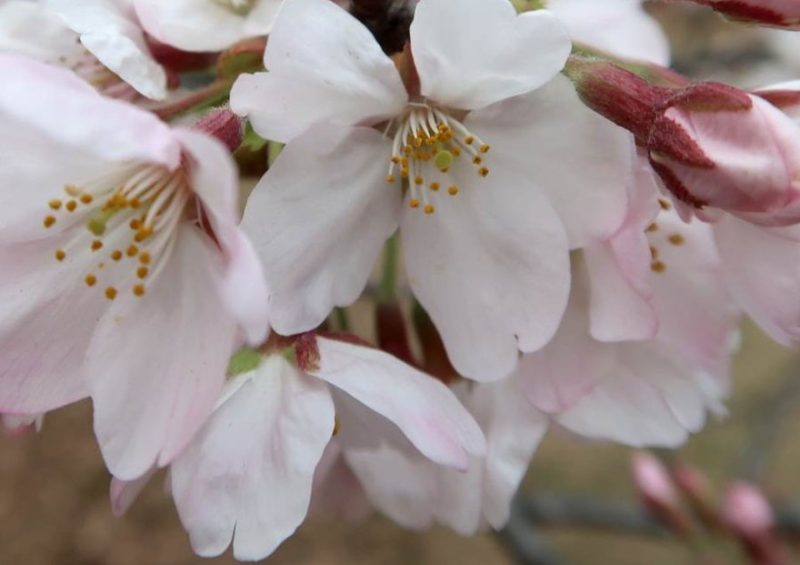
Yoshino cherry is a widely celebrated ornamental cherry variety, known for its delicate, pale pink flowers that bloom in early spring. The flowers appear in clusters and cover the tree’s branches, creating a light and airy canopy. Yoshino cherries are often associated with the famous cherry blossoms of Japan, and their gentle beauty makes them a favorite in both urban and suburban landscapes.
This tree thrives in USDA hardiness zones 5 through 9 and grows best in full sun with well-drained soil. Yoshino cherry is relatively easy to care for and does well in a variety of soil types as long as they are not too soggy. It is a fairly low-maintenance tree but will benefit from regular watering during dry periods, especially during the flowering phase. It is also resistant to many common cherry tree diseases but may require occasional attention for pests like aphids or caterpillars.
Yoshino cherry trees typically reach a height of 25 to 40 feet and have a wide canopy, making them ideal for larger landscapes, streetscapes, or public parks. The blossoms typically bloom in early to mid-spring, with the tree often becoming a focal point for photographers and nature lovers. After blooming, the tree produces dark green leaves that turn yellow in the fall. Pruning should be done in late spring, after flowering, to shape the tree and remove any dead or damaged branches.
Autumnalis Cherry
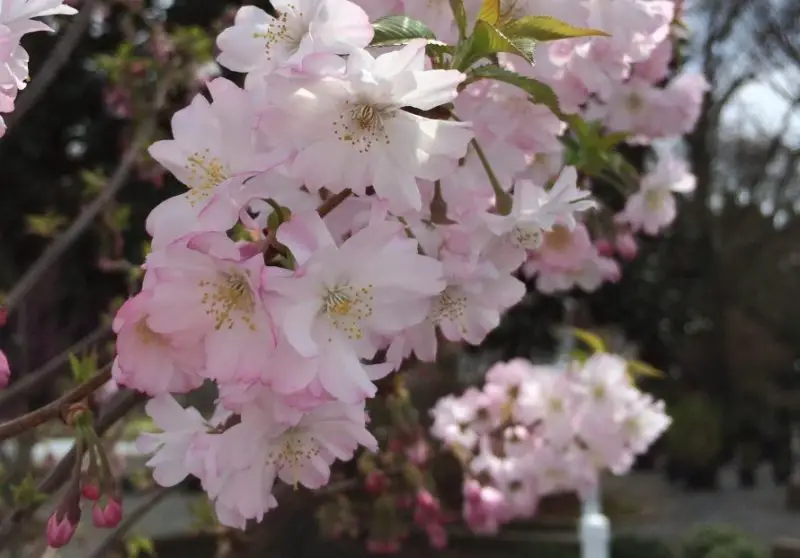
Autumnalis cherry is a unique ornamental cherry variety known for its late-blooming nature. Unlike many cherry trees that bloom in spring, Autumnalis flowers begin to emerge in the fall and can continue into early winter, offering a rare and long-lasting display. The flowers are soft pink and appear in clusters, creating a beautiful contrast against the tree’s dark bark and green foliage.
This tree thrives in USDA hardiness zones 5 through 8 and prefers full sun to partial shade, along with well-drained soil. Autumnalis cherry is known for being relatively hardy and tolerant of various soil conditions, though it should be watered regularly during dry spells, especially when it is flowering. It is resistant to most common cherry tree diseases, but like many ornamental cherries, it benefits from periodic care to prevent fungal issues.
Autumnalis cherry typically reaches a height of 15 to 30 feet, making it suitable for smaller gardens or urban landscapes. The tree’s unique blooming period, with flowers emerging in late autumn, makes it a standout in landscapes, especially in regions with mild winters. Pruning should be done in late winter or early spring to remove any dead or damaged branches and ensure the tree maintains its desired shape. Its late-season blooms provide an excellent display, offering beauty well beyond traditional spring flowering trees.
Sargent Cherry
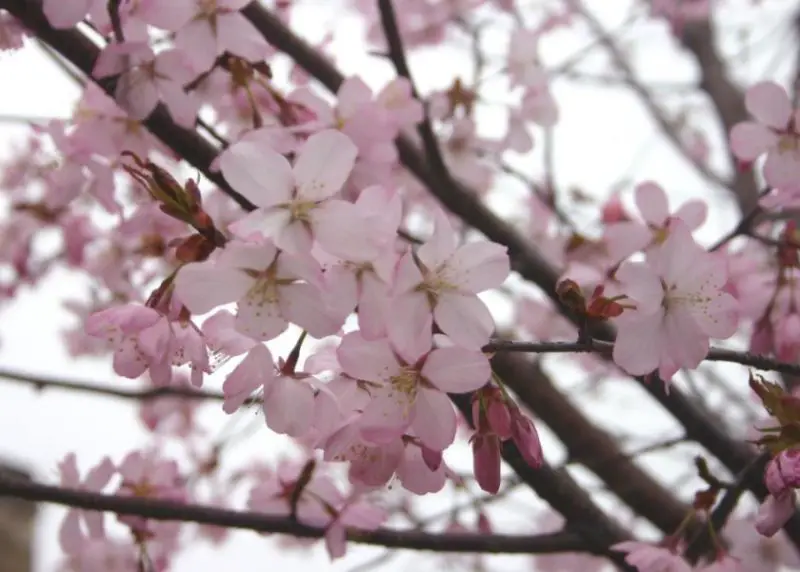
Sargent cherry is a small ornamental cherry tree that is known for its compact size, making it an excellent choice for small gardens, urban landscapes, or as a feature plant in landscape design. The tree produces small, pink to white flowers in early spring, followed by small, dark red to purple fruit that attracts birds. While the fruit is not typically eaten by humans due to its small size and sour taste, it serves as an important food source for wildlife.
This tree is hardy in USDA zones 4 through 8, making it well-suited for cooler climates. Sargent cherry prefers full sun and well-drained soil, but it is tolerant of a range of soil conditions. It is relatively low-maintenance and resistant to common cherry tree diseases, although it may occasionally require attention for pests like aphids or scale insects. Regular watering will help ensure healthy growth, especially during dry periods.
Sargent cherry trees typically grow to a height of 10 to 20 feet, making them perfect for small gardens, borders, or as an ornamental feature in parks. The tree blooms in early spring, usually in April, with the small, delicate flowers appearing before the leaves. After blooming, the tree’s leaves turn a vibrant green and often display beautiful fall colors. Pruning is minimal but should be done after flowering to maintain the tree’s shape and remove any dead or diseased branches.
Weeping Higan Cherry
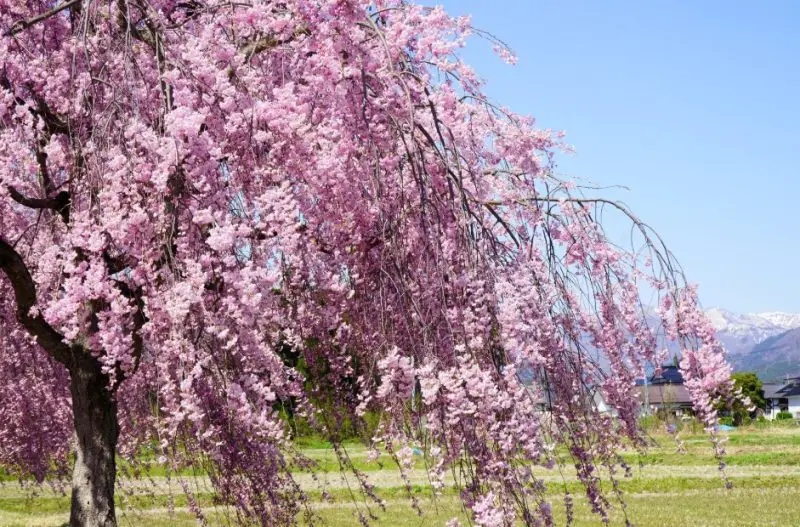
Weeping Higan cherry is an elegant ornamental cherry tree known for its dramatic, cascading branches that create a weeping effect. The tree produces soft pink flowers in early spring, which contrast beautifully with its graceful, drooping branches. The flowers appear before the leaves, and the tree’s unique, weeping form makes it a striking addition to any landscape.
This tree thrives in USDA hardiness zones 5 through 8, preferring full sun and well-drained soil. Weeping Higan cherry is relatively low-maintenance, requiring regular watering during dry spells, especially when the tree is in bloom. It is resistant to most common cherry tree diseases but should be monitored for pests such as aphids or spider mites.
Weeping Higan cherry typically grows to a height of 15 to 25 feet, with a spread of 20 to 30 feet. Its weeping branches give it a distinctive shape, making it ideal for use as a specimen tree in gardens, parks, or along walkways. The blooms typically appear in early spring, around March or April, and last for several weeks. Pruning should be done after blooming to maintain the graceful shape of the tree and remove any dead or damaged branches.
Shirofugen Cherry

Shirofugen cherry is a charming ornamental cherry tree known for its stunning white to pale pink flowers that bloom in late spring. The blossoms are large, often displaying a beautiful, almost snow-like appearance as they cover the tree’s branches. This variety has a graceful, spreading form with an elegant structure, adding a serene beauty to any garden or landscape.
The tree thrives in USDA hardiness zones 5 through 8, preferring full sun to partial shade and well-drained soil. It is a relatively low-maintenance tree but benefits from regular watering during dry spells, particularly in the summer months. Shirofugen cherry is relatively resistant to most common cherry diseases but should be monitored for pests like aphids or caterpillars.
Typically reaching a height of 20 to 30 feet with a similar spread, Shirofugen cherry makes an ideal choice for medium-sized gardens or as a specimen tree in public parks. The tree blooms in late spring, typically in April or May, and its foliage turns to a rich green in the summer, offering additional visual interest. Pruning is minimal but should be done after the blooming season to maintain its shape and remove any dead or diseased wood.
Snow Fountain Cherry
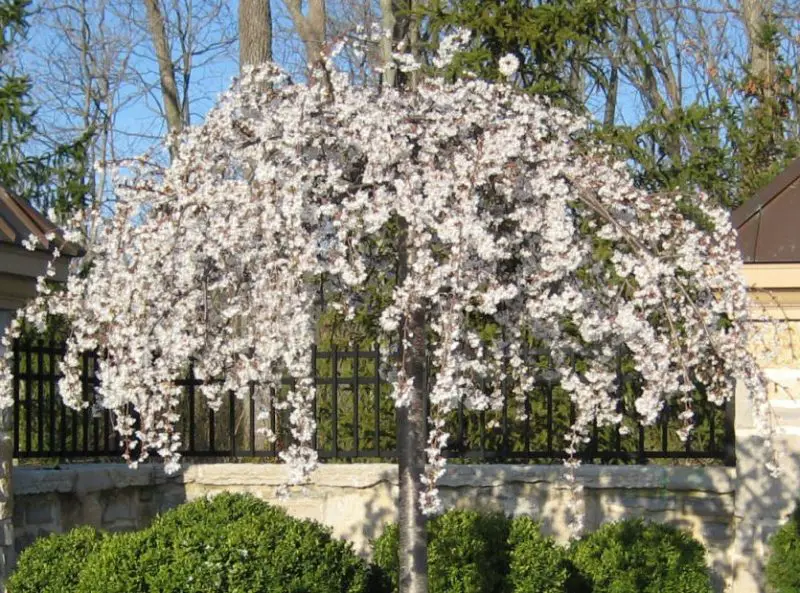
Snow Fountain cherry is a unique ornamental cherry tree with cascading, weeping branches that create a dramatic, flowing effect. The tree produces small, delicate, white flowers in early spring, creating a stunning visual display that looks like a fountain of snow. The flowers are followed by green foliage that turns a golden yellow in the fall, adding extra seasonal beauty.
This tree thrives in USDA hardiness zones 5 through 8, preferring full sun and well-drained soil. Snow Fountain cherry requires regular watering, especially during dry periods, to maintain its health and promote blooming. It is relatively resistant to most common diseases but should be monitored for pests such as aphids, spider mites, or scale insects.
Snow Fountain cherry typically grows to a height of 10 to 15 feet with a spread of 15 to 20 feet. Its weeping habit makes it an ideal choice for smaller gardens, as a specimen tree, or for creating a focal point along walkways or in front yards. Pruning is minimal and should be done after flowering to maintain the graceful shape of the tree and remove any dead or damaged branches.
Kanzan Sakura Cherry
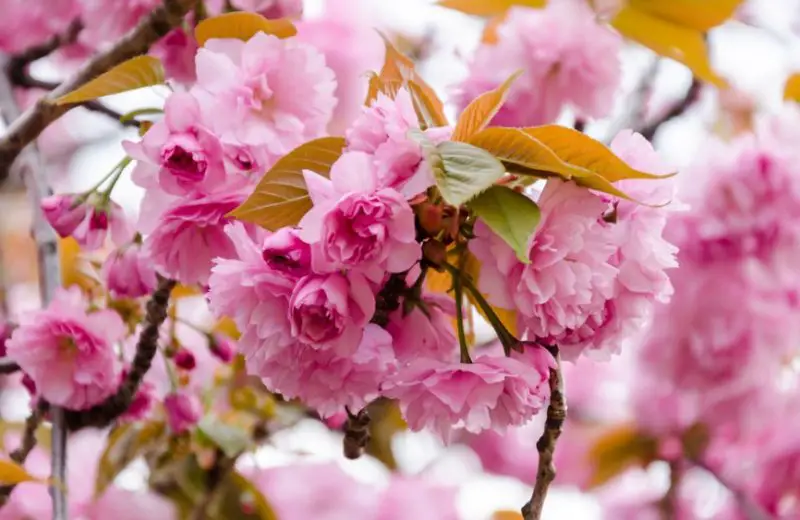
Kanzan Sakura cherry is a popular ornamental cherry variety, famous for its large, double-pink blossoms that appear in mid to late spring. The flowers are abundant and create a spectacular display, often covering the tree in a cloud of pink petals. Kanzan Sakura’s upright growth habit and dense foliage give it a bold, dramatic appearance, making it an attractive addition to gardens and landscapes.
This tree thrives in USDA hardiness zones 5 through 9, preferring full sun and well-drained soil. Kanzan Sakura cherry is relatively low-maintenance but should be watered regularly, especially during dry spells. While it is generally resistant to most common diseases, it may occasionally require attention for pests such as aphids, caterpillars, or fungal infections.
Kanzan Sakura cherry typically reaches a height of 20 to 30 feet, with a similar spread, making it suitable for larger gardens or as a focal point in public landscapes. The tree’s blossoms typically bloom in April or May, and after the flowers fall, the green leaves transition to yellow or orange in the fall, providing seasonal interest. Pruning is best done after flowering to shape the tree and remove any damaged or diseased branches.
Tibetan Cherry
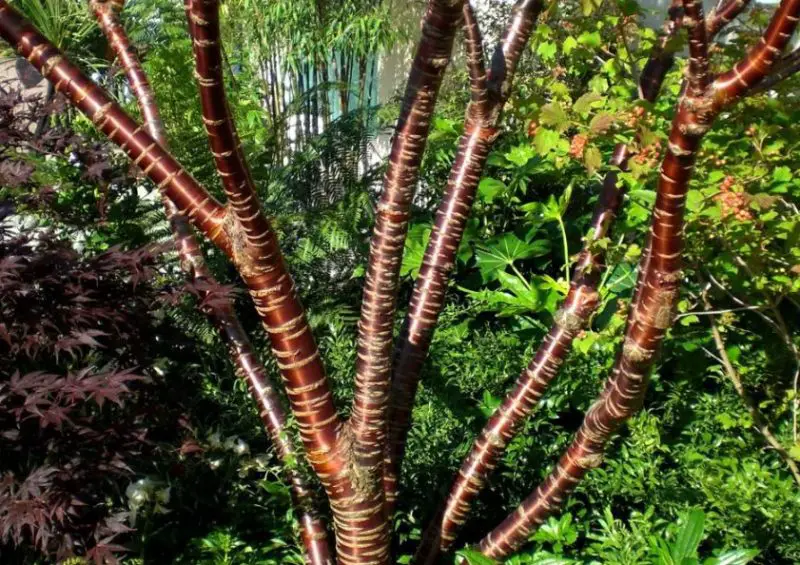
Tibetan cherry, or Prunus serrula, is a striking ornamental cherry tree admired for its glossy, reddish-brown bark that peels in delicate strips, revealing a smooth, shiny surface underneath. The tree produces small, white flowers in early spring, adding a soft contrast to its dramatic bark. The deep red bark of the Tibetan cherry stands out throughout the year, even in winter, making it a year-round focal point in gardens.
This tree grows best in USDA hardiness zones 5 through 8 and prefers full sun to partial shade. Tibetan cherry thrives in well-drained, slightly acidic soil, and it benefits from regular watering, especially during dry spells. It is relatively resistant to pests and diseases but should be monitored for common cherry tree issues like aphids or fungal infections.
Tibetan cherry typically reaches a height of 15 to 25 feet, with a similar spread. Its unique bark and modest flowering period make it an excellent choice for small gardens or as an ornamental tree in public landscapes. It is a great addition to areas where winter interest is desired, as the peeling bark adds color and texture when many trees are dormant. Pruning should be done in late winter or early spring to remove any dead or damaged wood.
Akebono Cherry

Akebono cherry is a cultivar of the popular Yoshino cherry, known for its large, pale pink blossoms that bloom in early spring. The flowers appear in clusters, creating a soft, delicate display of color before the leaves emerge. The tree has a graceful, rounded form with an open canopy that provides dappled shade throughout the warmer months, adding beauty to landscapes and gardens.
This tree thrives in USDA hardiness zones 5 through 8, preferring full sun and well-drained, fertile soil. Akebono cherry is relatively easy to care for and benefits from regular watering during dry periods to promote healthy growth and flowering. It is resistant to many common cherry tree diseases but may occasionally require attention for pests like aphids or scale insects.
Akebono cherry typically grows to a height of 20 to 30 feet with a spread of 15 to 25 feet. It is a great choice for medium to large gardens, streetscapes, or parks. The tree blooms in early spring, usually in March or April, and offers a soft, elegant display of color that lasts for several weeks. Pruning should be done after flowering to remove any dead or damaged branches and to maintain the tree’s shape.
Pink Star Cherry
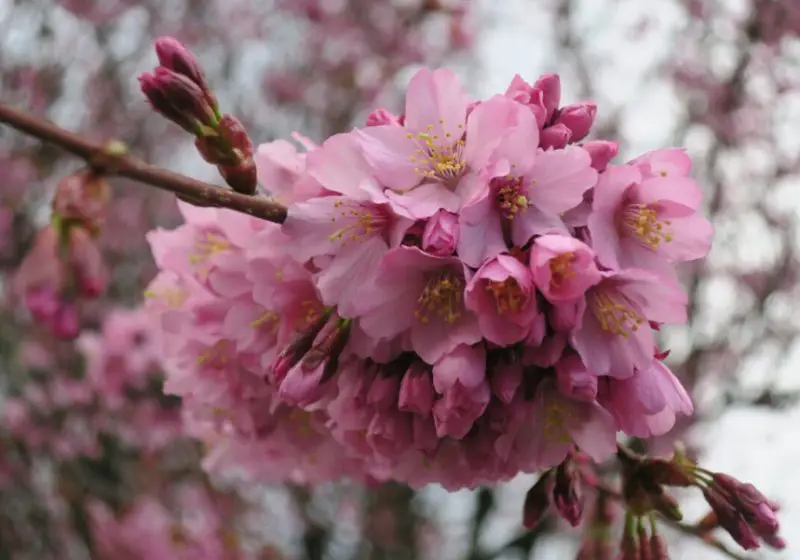
Pink Star cherry is a beautiful ornamental tree known for its eye-catching, pink flowers that bloom in early spring. The blossoms are large, with a striking contrast of pale pink petals against the tree’s dark branches. This variety has a rounded, compact form and is often chosen for its aesthetic appeal in gardens or as a feature tree in landscapes.
This tree thrives in USDA hardiness zones 5 through 8, preferring full sun and well-drained soil. Pink Star cherry benefits from regular watering, particularly during dry spells, to ensure it remains healthy and blooms profusely. It is relatively resistant to common cherry tree diseases but should be monitored for pests like aphids or fungal infections.
Pink Star cherry grows to a height of 15 to 25 feet, with a similar spread, making it suitable for small to medium-sized gardens or landscapes. The flowers bloom in early spring, often in April, and are followed by green foliage that turns yellow or orange in the fall. Pruning should be done after flowering to maintain the tree’s shape and remove any dead or diseased branches.






